|
|
Post by chaykinstevens on Apr 10, 2021 11:43:14 GMT -5
Looking at it now, the art is fine, though 3 pencillers adds for some confusion in story, though Bair & Murray do the bulk of it. curious how they worked as a penciling duo; did they alternate sections or what? Thomas talked about this in the next issue. After Tom Grindberg dropped out, Bair had been chosen as penciller, but turned out to be too slow for a monthly schedule. Murray was brought in to finish the pencilling of Bair's pages, which varied from almost complete to half-finished. The final page and the sequence introducing the Flying Fox were all Murray. |
|
|
|
Post by majestic on Apr 10, 2021 16:34:07 GMT -5
I liked Brian Murray's art. I only knew he did Young All Stars and early Liefeld Supreme. Did he do anything else?
|
|
|
|
Post by chaykinstevens on Apr 10, 2021 17:21:06 GMT -5
I liked Brian Murray's art. I only knew he did Young All Stars and early Liefeld Supreme. Did he do anything else? He pencilled the Badger #38, half an issue of X-Force over layouts by Rob Liefeld, and a Wonder Man story in Marvel Super-Heroes (1990) #4. |
|
|
|
Post by mikelmidnight on Apr 12, 2021 11:42:34 GMT -5
Thoughts: Okay....well, Roy hits us with a lot of introductions, but plenty of action during those introductions, making for an exciting comic. There is some mystery about Helena's dreams of death, Tsunami's actual transformation from Miya Shimada, an American-born student in Japan who returns to America as an agent of the Emperor (and the ruling military), who has abandoned her allegiances. We have no idea who the flying man is. nor Arn "Iron" Munro, other than he has a Scottish family name and a Scandanavian first name. Maybe his parents were fans of Prince Valiant. TNT and Dan the Dyna-Mite appeared at the mass meeting of the All-Star Squadron, but had little actual involvement in the adventures. Previously, they had appeared in a couple of issues of the Super Friends, the tie-in comic aimed at young children, who were fans of the cartoon. they were a sort of copy of Batman and Robin, though they had super powers, brought on by touching their rings together, giving them explosive force.
One of Roy's better retcons which did not see fruition: he originally wanted to replace Wonder Woman with the EC Comics heroine Moon Girl! I think that would have been a brilliant move and I don't know why it didn't work out … aside from everything else it would have been a 'family reunion' reuniting the creations of William and MC Gaines (EC continuity also had a costumed archer, of sorts, who could have filled in for Green Arrow).
I'll save comments on the other two once more is revealed about them in the series.
I think killing off TNT was a shame, but he was never a favorite. DC didn't have much in the way of super powered kid characters or sidekicks so I'm not sure who else he might have used in the 'Young' All-Stars.
Gudra was a take on the old WW foe Gundra.
I get … sort of … trying to 'recapture the energy' of the lost Superman, Batman, and Wonder Woman with this trio of teen heroes … but now he's doing it AGAIN, in the SAME SERIES, with these Axis counterparts. Additionally, of course, he had already done this trope back in The Invaders. So, right away, Roy lost me here.
|
|
|
|
Post by codystarbuck on Apr 12, 2021 21:48:05 GMT -5
Thoughts: Okay....well, Roy hits us with a lot of introductions, but plenty of action during those introductions, making for an exciting comic. There is some mystery about Helena's dreams of death, Tsunami's actual transformation from Miya Shimada, an American-born student in Japan who returns to America as an agent of the Emperor (and the ruling military), who has abandoned her allegiances. We have no idea who the flying man is. nor Arn "Iron" Munro, other than he has a Scottish family name and a Scandanavian first name. Maybe his parents were fans of Prince Valiant. TNT and Dan the Dyna-Mite appeared at the mass meeting of the All-Star Squadron, but had little actual involvement in the adventures. Previously, they had appeared in a couple of issues of the Super Friends, the tie-in comic aimed at young children, who were fans of the cartoon. they were a sort of copy of Batman and Robin, though they had super powers, brought on by touching their rings together, giving them explosive force.
One of Roy's better retcons which did not see fruition: he originally wanted to replace Wonder Woman with the EC Comics heroine Moon Girl! I think that would have been a brilliant move and I don't know why it didn't work out … aside from everything else it would have been a 'family reunion' reuniting the creations of William and MC Gaines (EC continuity also had a costumed archer, of sorts, who could have filled in for Green Arrow).
I'll save comments on the other two once more is revealed about them in the series.
I think killing off TNT was a shame, but he was never a favorite. DC didn't have much in the way of super powered kid characters or sidekicks so I'm not sure who else he might have used in the 'Young' All-Stars.
Gudra was a take on the old WW foe Gundra.
I get … sort of … trying to 'recapture the energy' of the lost Superman, Batman, and Wonder Woman with this trio of teen heroes … but now he's doing it AGAIN, in the SAME SERIES, with these Axis counterparts. Additionally, of course, he had already done this trope back in The Invaders. So, right away, Roy lost me here.
I kind of thought he should have gone the reverse route, with Axis Amerika being Marvel pastiches, as he did with the DC ones in Invaders. Granted, that was done in Freedom Fighters, for the unofficial crossover, the the Crusaders groups fighting each company's team (Quality pastiches fighting the Invaders and Marvel pastiches fighting the Quality bunch, at DC). Roy had also done the Teutonic gods route in Invaders, in the first couple of issues. |
|
|
|
Post by codystarbuck on Apr 14, 2021 14:56:51 GMT -5
Young All-Stars #2 Tsunami gets the cover this issue. Hope it's been at least an hour, since eating! Creative Team: Roy & Dann Thomas-writers, Brian Murray-pencils, Malcolm Jones III-inks, Jean Simek-letters, Carl Gafford-colors Bill Murray's brother is penciling? Okay, that's Brian Doyle Murray; but, it would be cool. And Grumpy! Synopsis: The Statue of Liberty is taking a stroll down the streets of Manhattan, when she is mugged by Adolf Hitler, Benito Mussolini and Hideki Tojo... 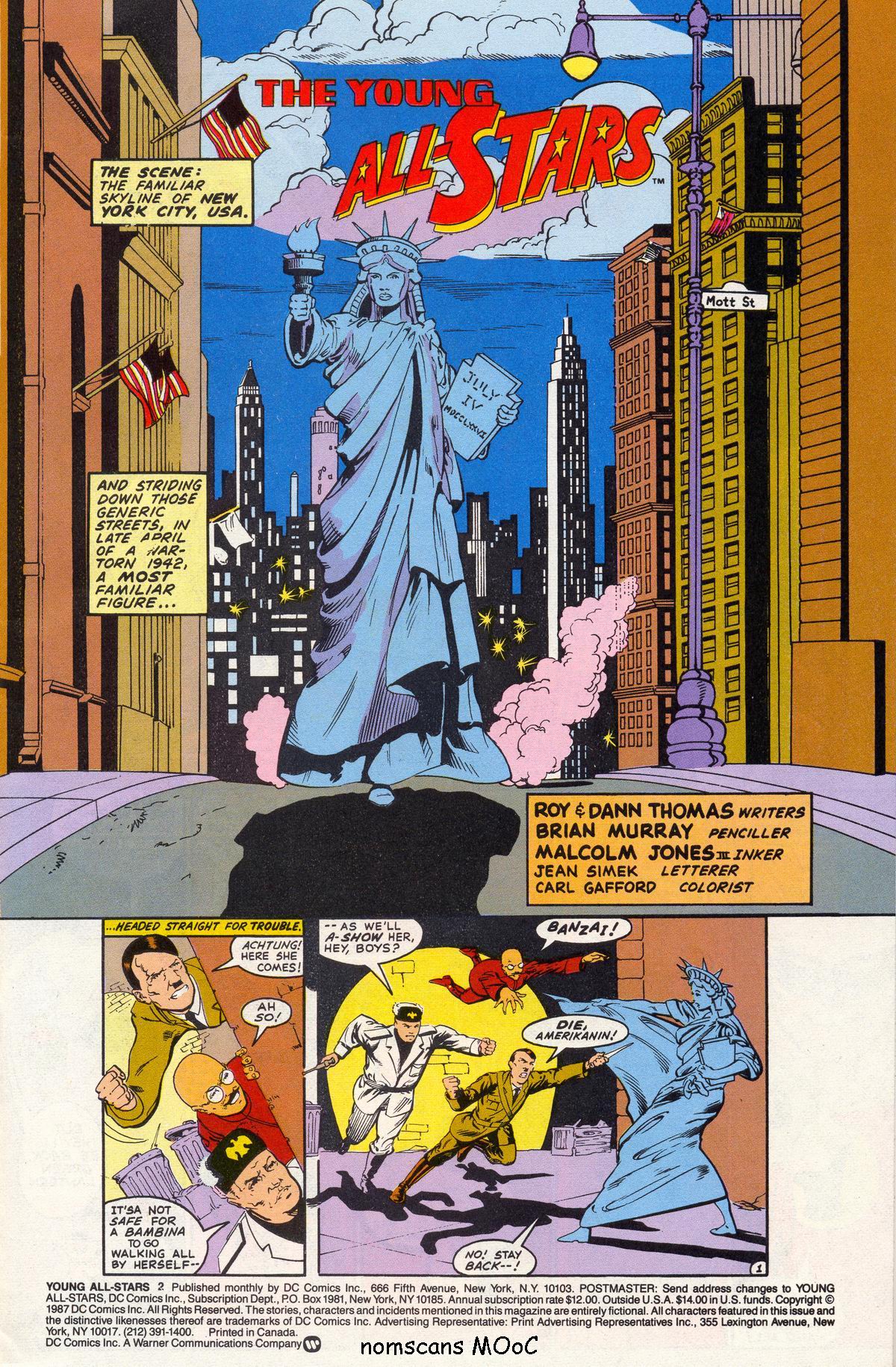 Green Lantern and Doioby turn up to save her from the Fascists and it all turns out to be a war bond short, whose filming is interrupted by Neptune Perkins and Tsunami. Tsunami relates events from last issue and a meeting with Sea Wolf, of Axis Amerika. She has been assigned to the team, but Sea Wolf is a little too much wolf... 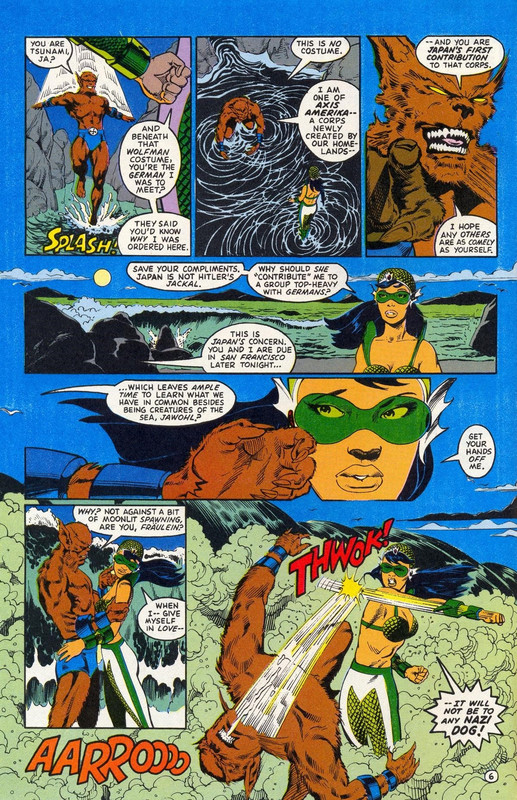 ...and she tells him and Axis Amerika to take a hike. She is a woman without a country, turning her back on Japan and feeling like the US has turned its back on the Japanese-Americans. They all depart for New York to meet up with the All-Stars and share the threat of Axis Amerika. Meanwhile, Arn Munro visits Dan Dunbar in the hospital. Dan is told that Tex Thomas (not Tex Thompson, aka Mr America, the Americommando) is dead and relates their past, but it is over. Shining Knight turns up, though, at first, Arn thinks it is Gudra. Arn relates what happened and goes off with Sir Justin to meet the All-Stars. Libby & Johnny arrive in New York, with Helena and we elarn that the Freedom Fighters have now left the All-Star Squadron (since they didn't go to a parallel Earth) and are in Washington DC. The meeting is interrupted by Axis Amerika, who make introductions, in a rather clumsy fashion... 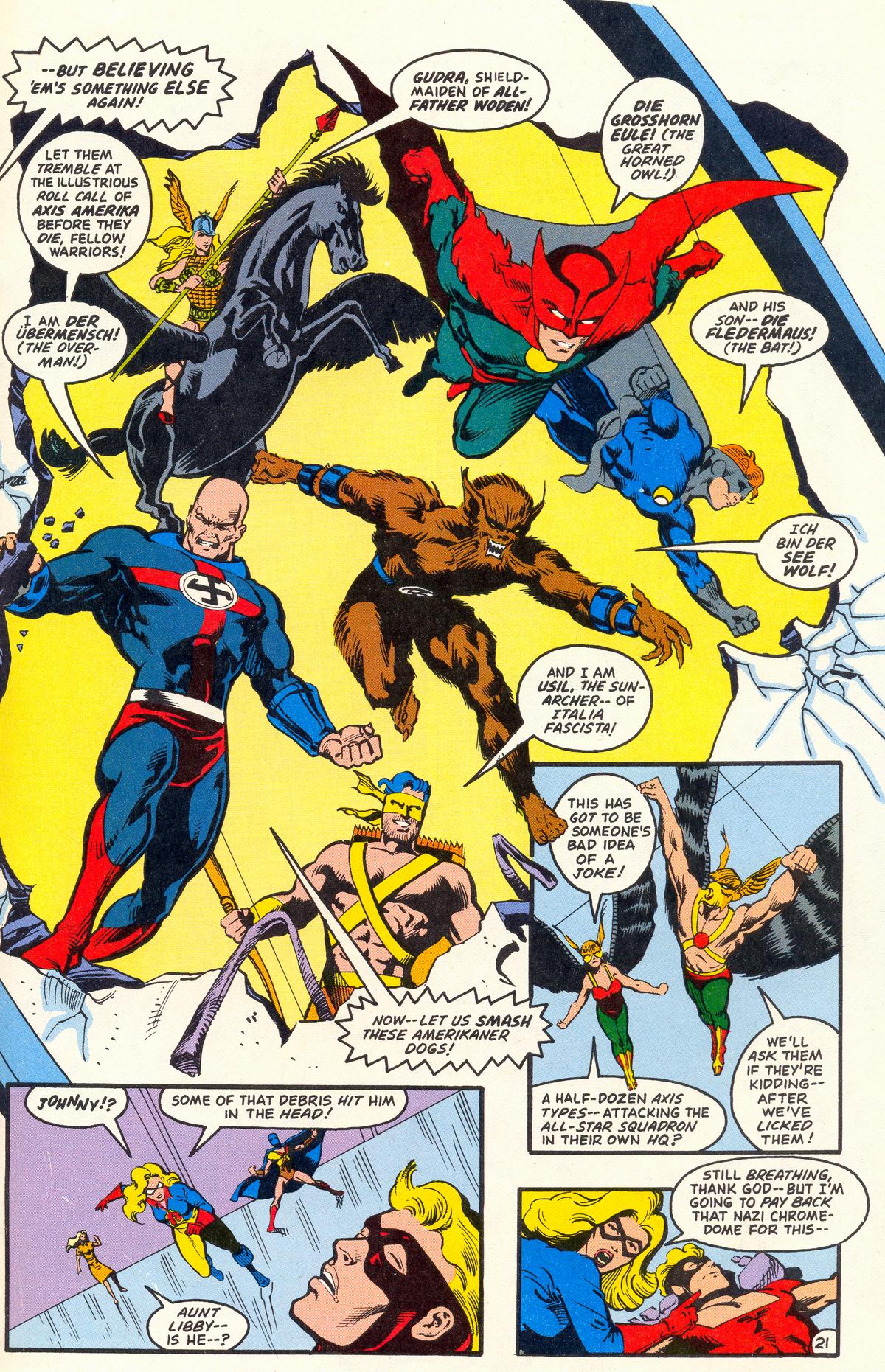 So, one Italian in the bunch, and no Japanese, since Tsunami told them to get stuffed. Ubermensch, Gudra, Grosshorn Oul (Great Horned Owl), Fleidermaus (insert Tick joke), Sea Wolf and Usil (wait, Paul Atreides?). Guess Zyklon couldn't make it. They fight, Libby gets clobbered and Helena transforms into Fury. Ubermensch seems to think it is funny. 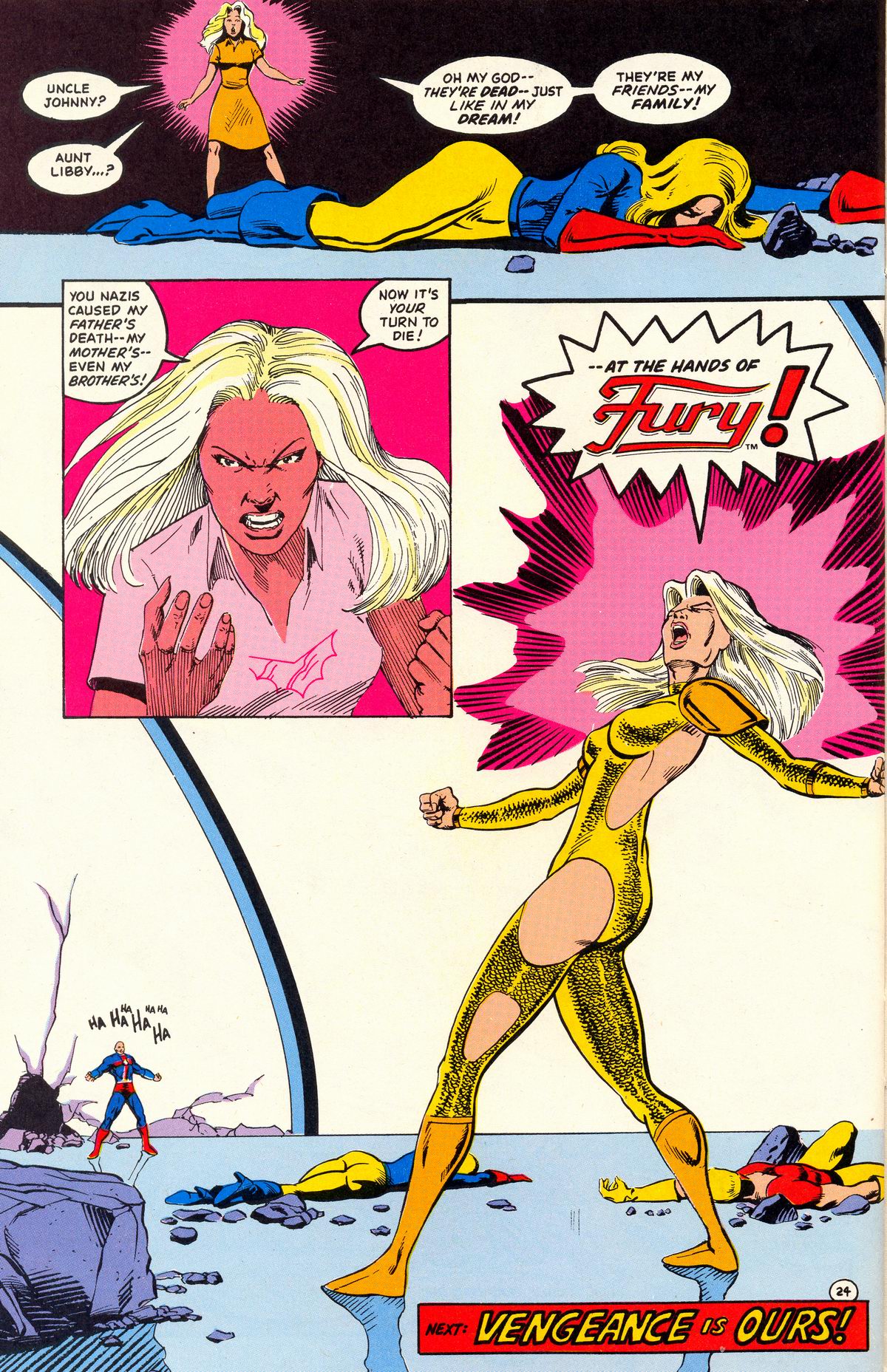 Thoughts: Thoughts: Weeellllllll.....not quite as exciting as last issue and Brian Murray solo doesn't looks quite as good. Several panels have minimal background detail and figures seem to float in space. The figures aren't bad, but there is some real over-emotion to some of the facials, in spots. Turns out, Murray worked in tv animation and his work does have an animation quality too it, which might explain the over-emoting and minimal backgrounds. Murray won't be flying solo, next time, so we will see how things shape up. As for story, ton of exposition, a lot of rehashing of last issues events, and a lot of people standing around. Guess they figured a lot of people might have missed the first issue. Hope this is just a one-off and not a sign of a trend. Historical Notes: The Green Lantern opening is based on a two-page war bond piece in All-American Comics #44. Aside from that, it's still April, 1942, since only about 24 hours has passed, at most, since last issue. June 1945: In the Pacific, fighting on Okinawa draws to a conclusion, by the end of the month. Casualties have been high on both sides and the civilian death toll is horrendous, both from fighting and suicide, as Japanese propaganda suggested that the American soldiers would butcher them. As it was, given the fierce nature of the fighting, some soldiers were not too choosy in deciding friend or foe. HBO's the Pacific shows Eugene Sledge grappling with his own battle lust and hatred, which will continue to haunt him for some time after the war. In Europe, the Occupation formally begins, as the Allied Control Council formally takes command of Germany and Austria. Germany is split into 4 occupation zones. The American Zone consists of Bavaria, Hess, Wurttemberg-Baden and the ports or Bremen and Bremerhaven. The British controlled North Rhine-Westphalia, Schleswig-Holstein and Hamburg. Bremen and Bremerhaven came under British control in 1947. Belgium, Poland and Norway held smaller zones within the British zone, providing occupation troops The Belgians controlled and area along their border with Germany, including the cities of Cologne and Aachen. The Polish were denied a formal sector, due to Soviet opposition, but administered a district near Elmsland, with a camp created to help repatriate displaced Poles, administered by the Polish Government in Exile. It was dismanlted after the British recognized the pro-Soviet Polish government. The French controlled Rheinland Pfalz, Baden, and Wurttemberg-Hohenzollern, as well as Saargebeit. The Soviet Zone consisted of Saxony, Saxony-Anholt, Thuringia, Brandenburg and Mecklenburg. The City of Berlin, which fell in the Soviet Zone, was divided between the four powers. The German territories of Farther Pomerania, Silesia, the new March and southern East Prussia fell under Polish administration, and were later absorbed into Poland and the USSR. Work began on de-Nazification of government (which was far from successful), as well as the media and other facets of German life. Displaced persons camps were set up to help persons removed from their home countries by the Nazis (either as slave labor or concentration camp inmates) to be reunited with family and return home. With the Soviet control of most of Eastern Europe, many from those areas were reluctant to return home and many Jews had no wish to return and wanted to emigrate to Palestine. Austria was also divided into 4 sectors, with Vienna, itself, divided into 4 sectors. The Soviets occupied Lower Austria and Bergenland. The British controlled Styria, Carinthia and Eastern Tyrol. The French controlled Tyrol and Vorarlberg. The US administered Upper Austria and Salzburg. On June 24, the Soviets held a victory parade in Red Square. On June 26, the United Nations Charter is signed, formalizing the organization, dedicated to preventing future wars and providing a channel for diplomatic communication.
|
|
|
|
Post by mikelmidnight on Apr 16, 2021 11:36:04 GMT -5
The Green Lantern opening is based on a two-page war bond piece in All-American Comics #44. Aside from that, it's still April, 1942, since only about 24 hours has passed, at most, since last issue.
I did not know this! This is the sort of historical rehashing I don't mind at all - it's short and brings into the comic something that wouldn't have been seen otherwise.
|
|
|
|
Post by codystarbuck on Apr 16, 2021 21:24:55 GMT -5
The Green Lantern opening is based on a two-page war bond piece in All-American Comics #44. Aside from that, it's still April, 1942, since only about 24 hours has passed, at most, since last issue.
I did not know this! This is the sort of historical rehashing I don't mind at all - it's short and brings into the comic something that wouldn't have been seen otherwise.
I had no problem with that (other than the director didn't look very 1940s Hollywood); just when Roy would spend an issue or 10 trying to link continuity to some minor 1940s story. It was goofy enough to get a pass, without bringing the story to a grinding halt. Some of what Roy was doing in Infinity, Inc, at the same time, was a different story. |
|
|
|
Post by codystarbuck on Apr 18, 2021 20:29:39 GMT -5
Young All-Stars #3 Flying Fox gets the cover this time. He is a member of the First Nations of Canada; so, of course, he is given a red skin color. *Sigh* I suppose I should be happy that Tsunami was only given an orange color and not a yellow. Had Fury been a male Greek character, instead of female, I suppose the character would have been tan, with black hair and a beard. Since she was female, we of course got blond as that is such a common hair color in Mediterranean Greece. I suppose every Celt has red hair. Oh, wait, Danette Reilly, a red head. Yup! End of gripe. Creative Team: Roy & Dann Thomas-writers, Brian Murray & Howard Simpson-pencils, Malcolm Jones III-inks, Jean Simek-letters, Carl Gafford-colors Murray pencils the first 15 pages and Simpson the rest. Synopsis: Fury and her armored cleavage face down Axis Amerika... 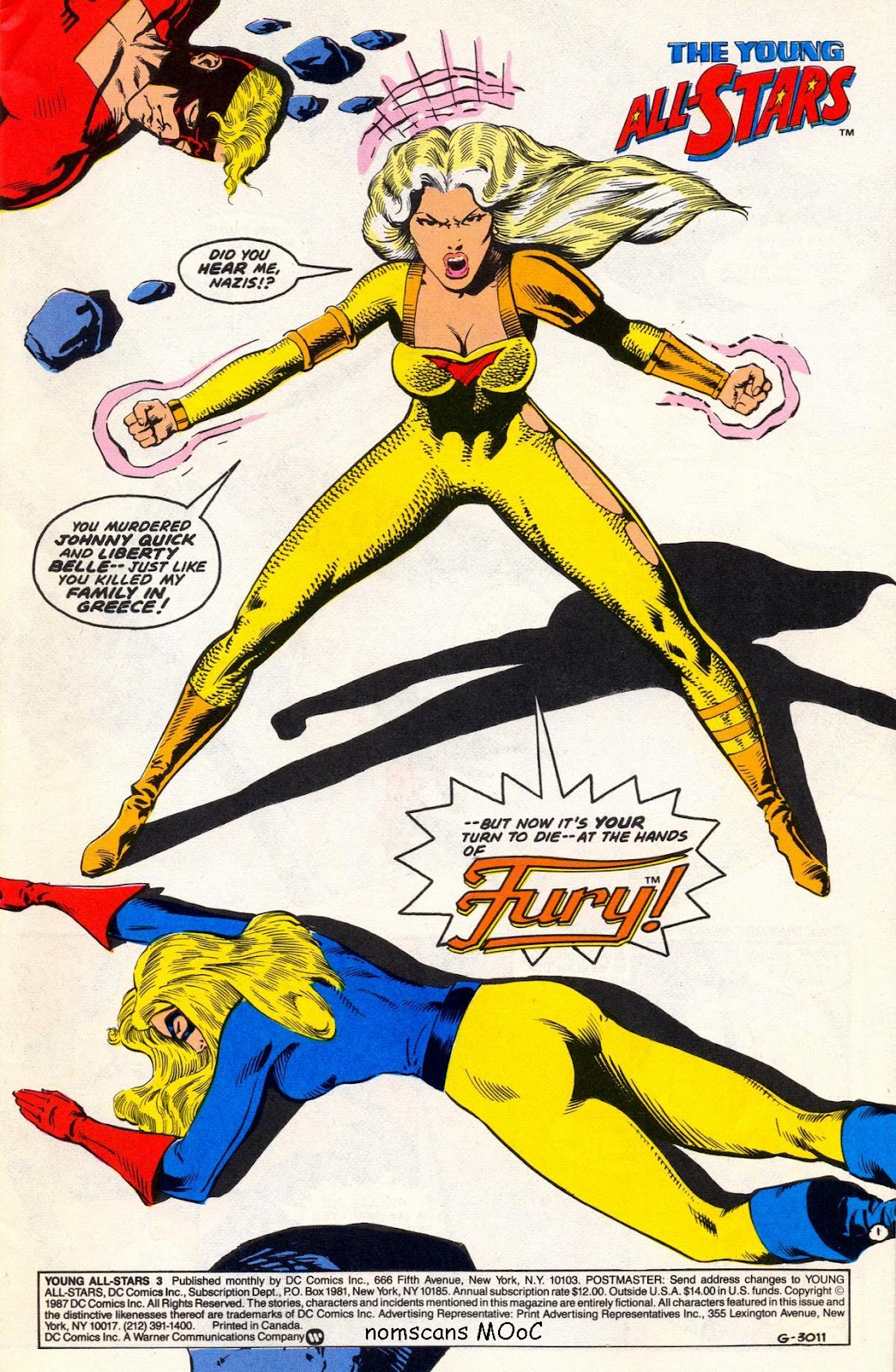 ...who are fighting the All-Stars... 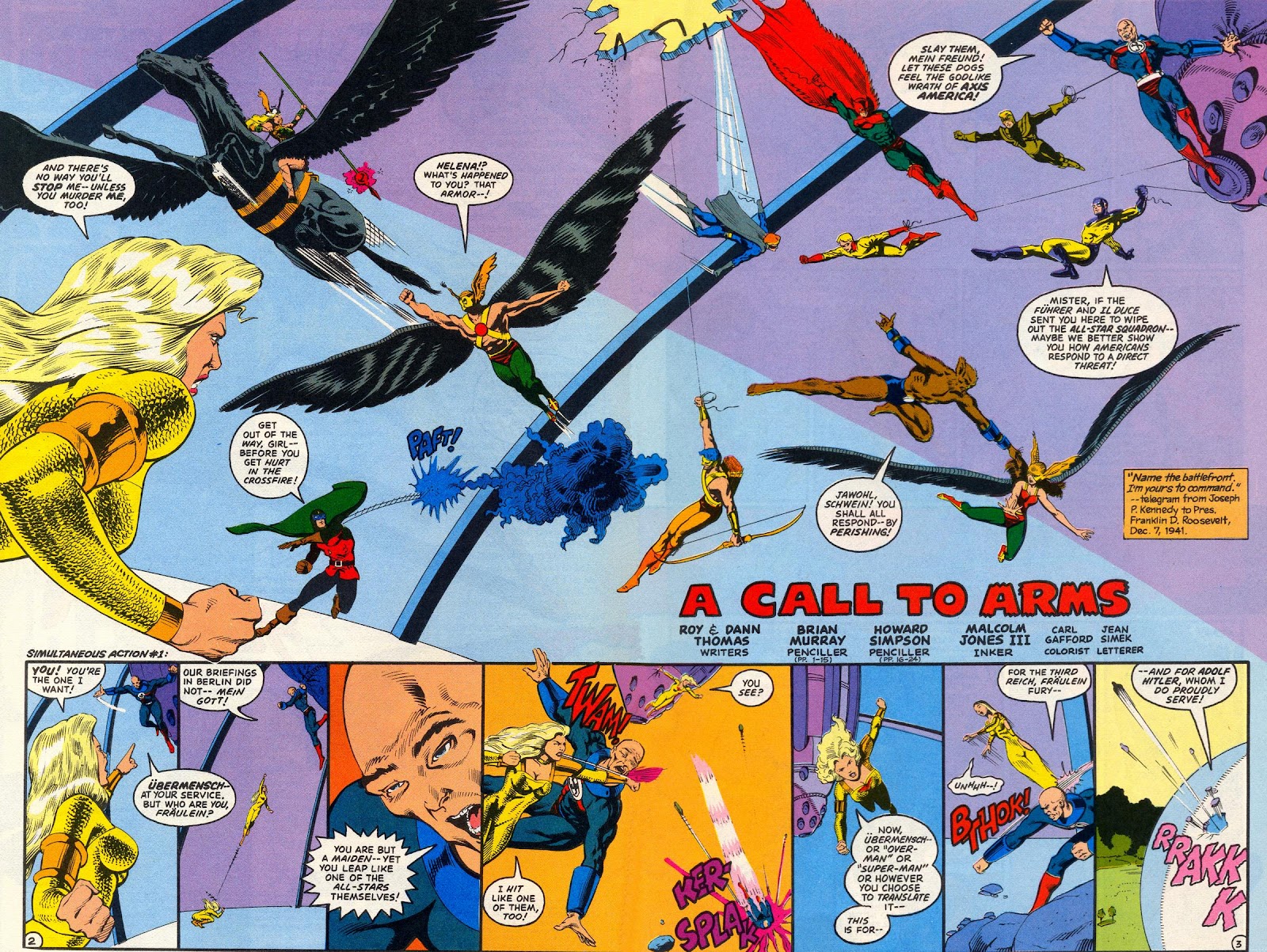 Fury points at Ubermensch and says, "You're the one I want...." Ubermensch then discusses Thetans and auditing, but Fury isn't interested, so they trade punches. Amazing Man protects Dr Midnite from Usil's arrows and it turns out he was also at the 1936 Olympics and wants revenge, even though he is Italian, not German. He fires an exploding arrow that actually takes Amazing Man down. Horned Owl takes down both Tarantula and Sandman, after they make fun of his name (in English). Fleidermaus tries blinding Sandy, but he still kicks his but, putting him one up on his boss/mentor. Sea Wolf once again shows his attraction to the ladies, as he attacks Hawkgirl, then fends off Firebrand. He suckers her into bursting a water pipe which extinguishes her, but is too busy gloating to catch Flying Fox's entrance. Foxy zaps him with some kind of light, then an illusion of himself, before KO-ing him. Gudra takes on both Hawks and fires her spear at Hawkgirl... 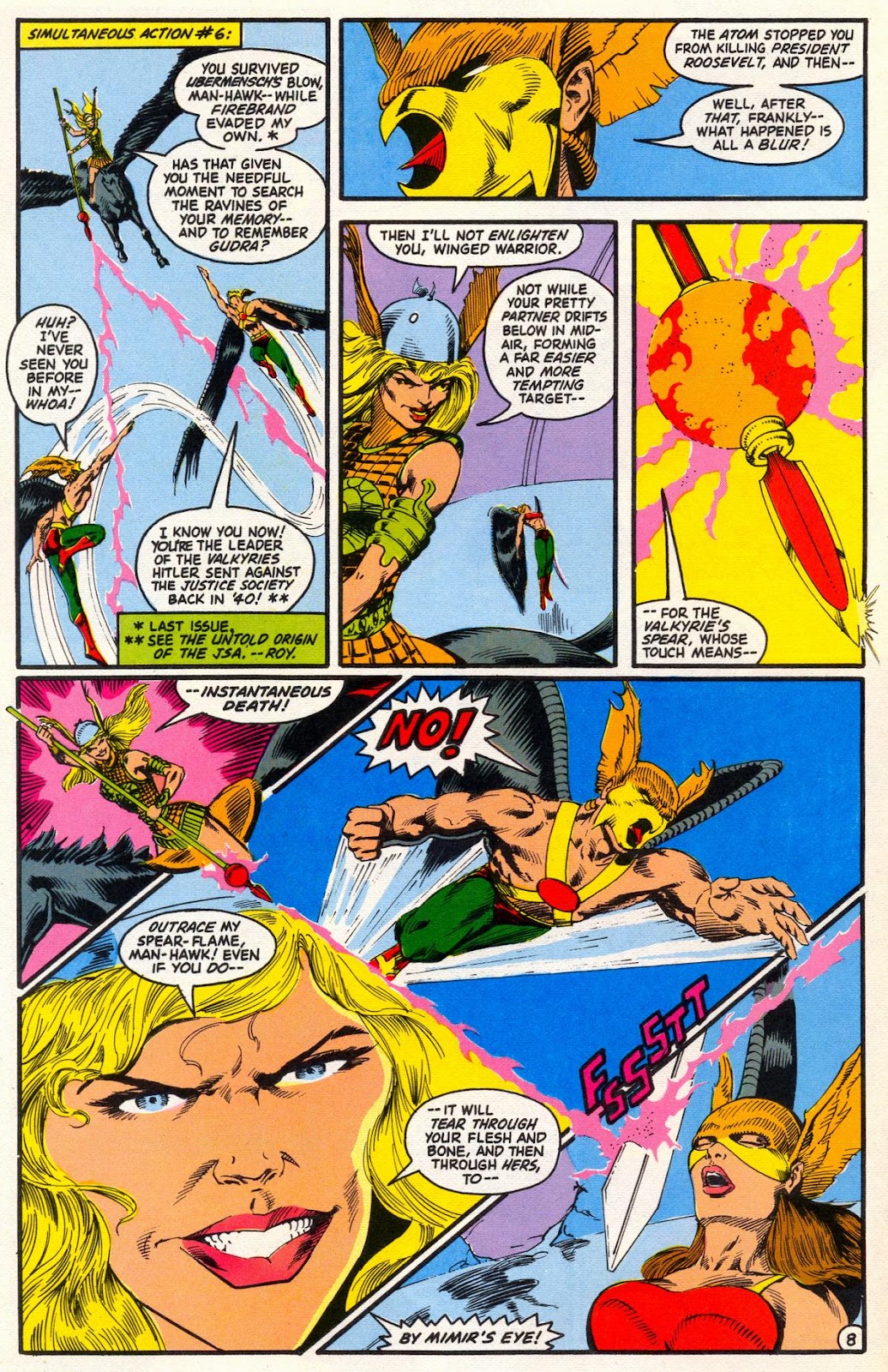 ...but Shining Knight intercepts it with his own mystic sword (everybody in Camelot had a mystic sword, it came with your Round Table Decoder Ring). He also drops off Iron Munro, who stops Usil with a flick of his finger, eliciting a "Mama Mia!" before his lights get put out... 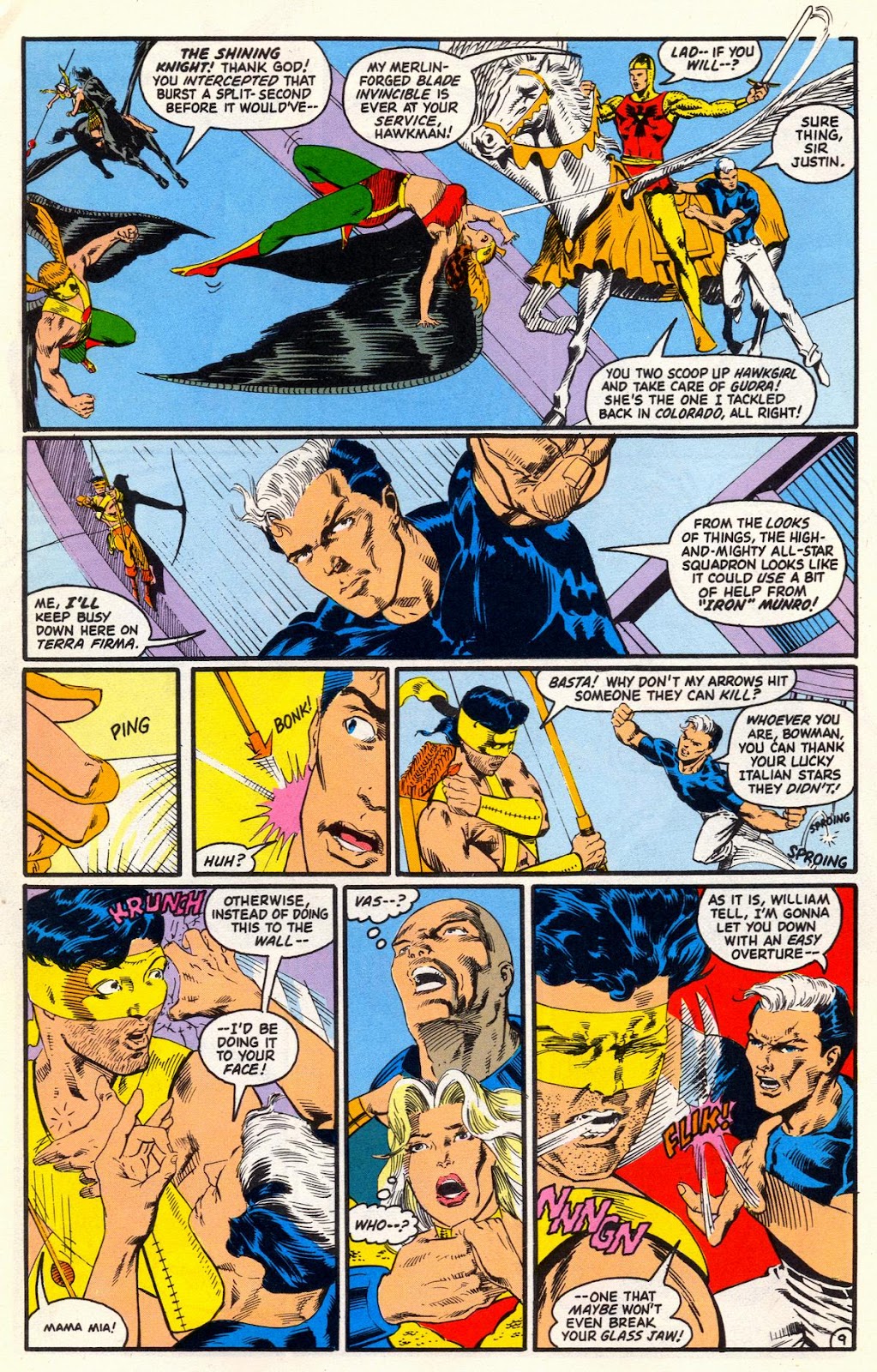 Pasta fazool! Ubermensch spots Munro and falls in love and swats away Fury so that he can play with the muscled pretty boy... 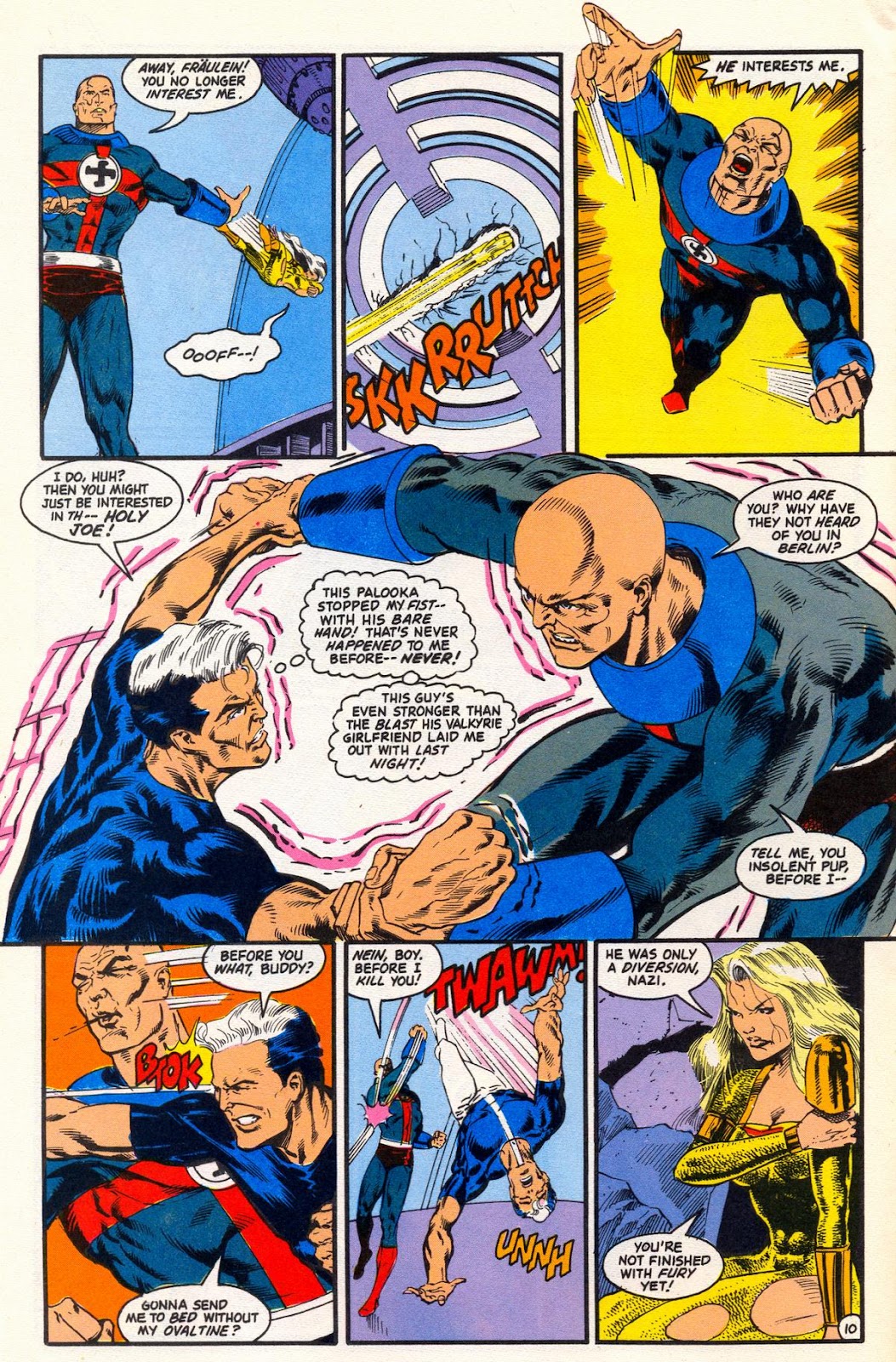 Munro gets knocked down, but he gets up again....you're never gonna keep him down... Ubermensch trips his Fascist League Communicator and they beat a hasty retreat. They all climb into a flying saucer and disappear, just as Green Lantern turns up, with Tsunami and Neptune Perkins (still sounds like he should be hosting programming on A&E, in the mid-90s). GL assesses the situation and Sandy lets loose with a racial slur (though pretty common in the period, right down to newspaper headlines and newsreels and cartoons), until Sandman tells him to simmer down and confesses that his leg is probably broken. Iron Munro starts hitting on....er, complimenting Fury and she goes off on him.... 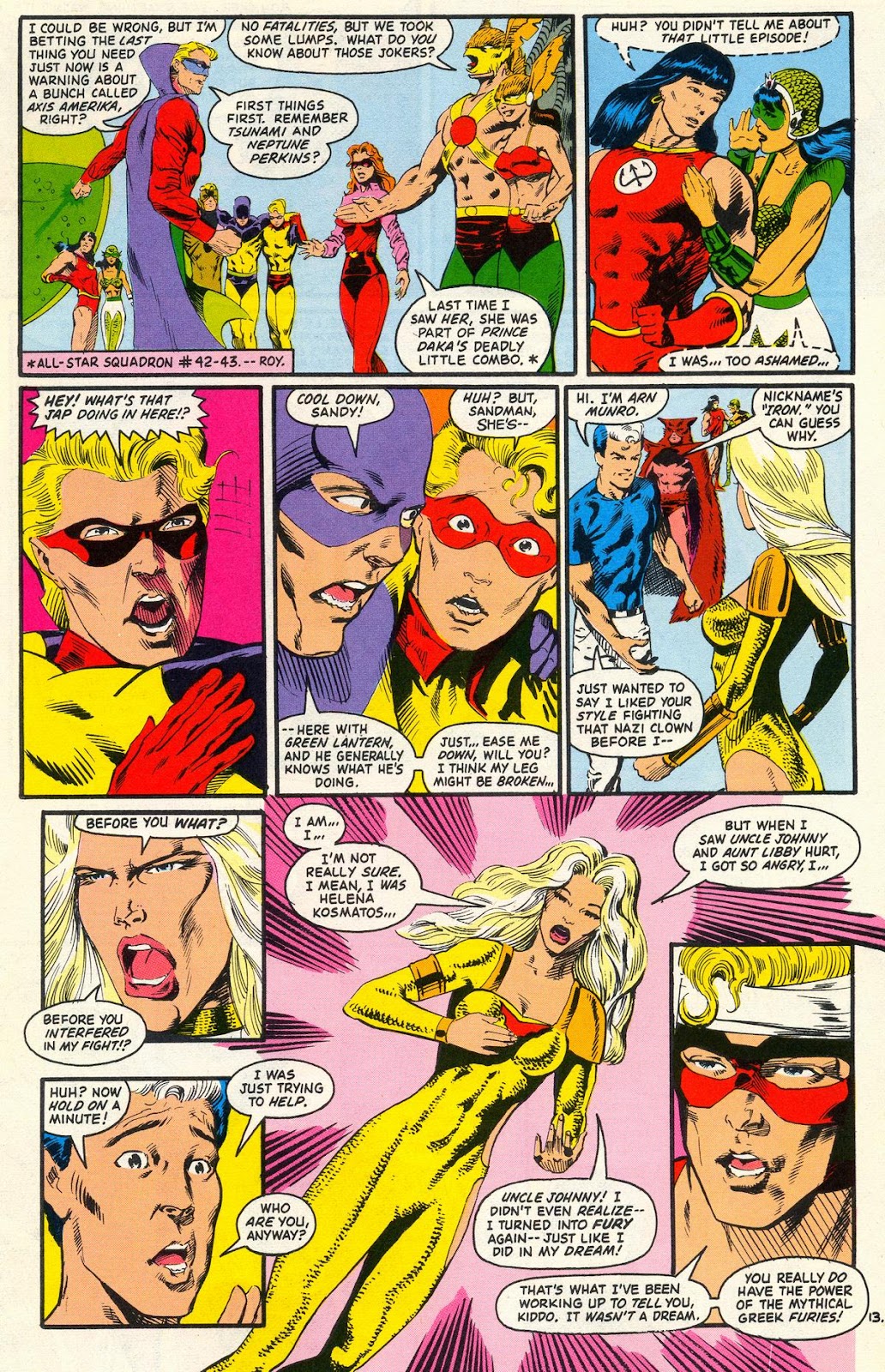 Hell hath no woman like a Fury patronized! Munro introduces himself to the other newbies and pretty much comes off as a complete @$$. Everybody things everything is coll now, until Sir Justin harshes the vibe be relating that TNT s dead and Libby now feels like she sent him to his death, since she dispatched him to Colorado. Johnny comforts her and Munro relates that Dyna-Mite is okay, at a hospital. Hawkman usurps Liberty Belle's authority and sends her off to the showers while he takes over. Everybody starts asking about the rookies. Later, Dan the Dyna-Mite hitches a ride with FDR, who is coming to the Perisphere to posthumously award the Medal of Honor to TNT, in front of the assembled All-Star Squadron... 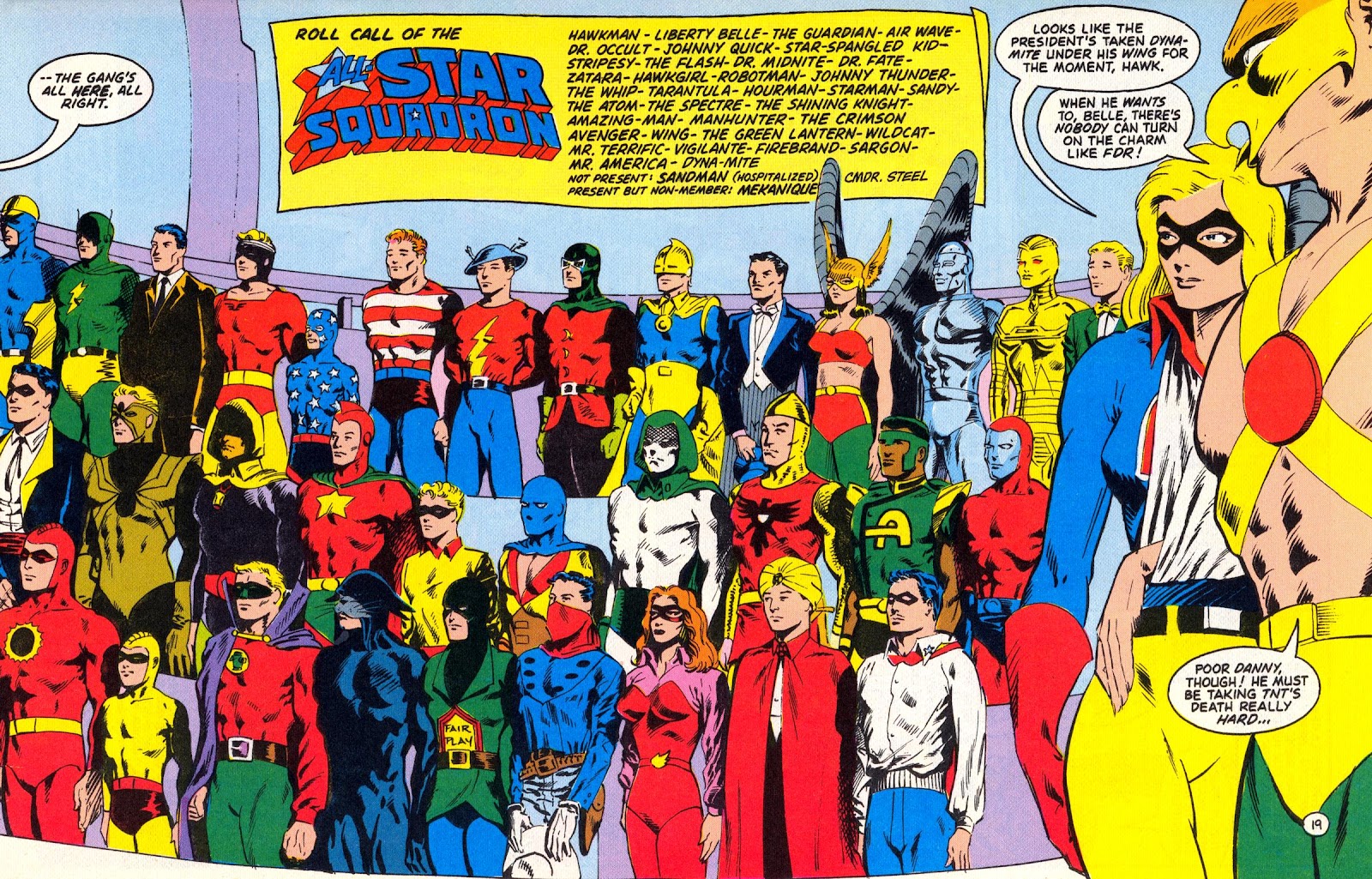 (minus the absent Cdr Steel and the Freedom Fighters, who broke away, but with Mekanique there) FDR says that the All-Stars are considered part of the military, by Act of Congress, thus making TNT eligible for the Medal of Honor (not the Congressional Medal of Honor, as Roy and many others mistakenly call it). Dan accepts the award and Howard Simpson apparently had no idea what it looked like or what the presentation box looked like, since he just draws a gold box with a laurel wreath. Dan accepts the award and goes off to blubber on Libby's injured shoulder. Hawkman calls out the rookies and introduces them to the President. Tsunami then speaks up and Roy tries to retcon the internment of Japanese Americans with Tsunami's speech and has FDR pass the buck that it's his advisors calling for it and he will consider what she says before he implements such a thing. Uh-hunh. The rookies are given provisional status as All-Stars and will be sent on a war bond drive tour. Sandy agrees to go so he can keep an "eye on the 'Jap' spy." Starman shares his cynicism, since James Robinson isn't writing this. Star Spangled Kid maintains his status as a full-fledged member, though Dyna-Mite and Sandy are lumped in with them. Stripesy cracks a joke about it and the Kid makes him wash the car (he is the chauffeur). Axis Amerkia listens via a "bug", planted in the meeting chamber. Thoughts: Well, the All-Stars get whooped by Axis Amerika, but saved by a bunch of rookies who are now the Pee-Wee League All-Stars. More or less, Roy is following the trend of youth-oriented superhero teams, like the X-Men (at first, though less so as time wore on), the Teen Titans (especially the "New" version), the Legion of Superheroes, the New Mutants and they would be followed by Marvel doing the same thing with the New Warriors. First problem is why anyone should care about a bunch of rookies who are fill ins for established characters, to fulfill a role that few beyond Roy seem to think is necessary. For me, this is one of the reasons why Young All-Stars never quite had the fan base that the All-Star Squadron had (at least, initially). People had a connection to some of the All-Stars and Roy threw in some interesting lesser known characters and built them up. He's trying the same thing here, but with a different mission statement. Before, he wanted to explore the wartime activities of the JSA and the other mystery men. He would use past continuity; but, he was creating new stories. Now, he is creating new characters to replace one that were altered by Crisis but were still top dogs, for DC (well, except maybe Aquaman). Roy seemed to feel they needed replacements. It's debatable. Superman, Batman and Wonder Woman were pretty much honorary members of the JSA, since they had solo books. The other characters were the heart and soul of the title. Batman is easily removed as there are other masked vigilantes in that era and his stories are fairly timeless; so, you can just slot them into the past of the modern post-Crisis Batman. Superman and wonder Woman are trickier, as Wonder Woman (the earth-2 version) was given a daughter and that character was not wiped out in Crisis. so, she needed a mom; but, nothing much else was crying out for a 1940s Wonder Woman, except maybe Paula von Gunther, who was a Nazi spy (though retconned into being coerced into working for the Nazis, despite a pretty sadistic personality in her earlier stories). You can still have a JSA without a "secretary." So, Roy creates a Golden Age Fury. Okay, that works. Superman is a bit different. He is supposed to be the first superhero. He inspires everyone else. So, you need a new "first superhero." Crimson Avenger, as the first masked hero at DC, got slotted into that role. So, is there any other need for a Golden Age Superman? There are other super strong characters, so why a new one? Well, Roy's justification is that he wants those old Superman stories to still count, but needs a substitute. Is that really necessary? No; but, Roy's idea will become an interesting twist on the idea of a Golden Age Superman, by giving us the guy who inspired the character in the first place (well, one of them, as there were a few inspirations). So, at least Roy has somewhere to go, here. Do we really need or even want a Golden Age Aquaman? Aquaman was one of the rarer instances of DC swiping from another comic company (they usually reserved their swiping for the pulps), as he was their attempt at a Sub-Mariner. He wasn't that big of a figure in the 40s and had a higher profile in the later 40s and after, though was never a real "star." Neptune Perkins isn't much of a substitute, either. He only had 2 appearances, before Roy dropped him into All-Star Squadron and they were in the late 40s, not during the formative years. He really seems to be there to make this more like the more familiar JLA, for modern readers and for someone to be a potential love interest for Tsunami. Dyna-Mite was one half of a mostly derivative team that few remembered then and ended up only getting decent use in the hands of James Robinson, if you ask me. Flying Fox isn't really even a Batman substitute as he has more in common with Hawkman; but, he is ethnic, which helps add to diversity. The name was likely chosen because it is another name for a species of fruit bat; but, said species is not found in North America. Tsunami is there for both gender and racial diversity, while highlighting the treatment of Japanese-Americans during the war, both the internment and the legacy of the Nisei soldiers, like the 442nd Regimental Combat Team. Tsunami's plea to Roosevelt feels more like Roy trying to absolve FDR (one of his heroes) of the responsibility of the Executive Order that deprived Japanese-Americans of their civil rights. It is pure hindsight. The feelings would probably be real to a Nisei, and certainly reflect the attitudes of many who volunteered for military service; but, it has such anachronistic atmosphere that it ends up hurting the story. I think Tsunami makes for an interesting character to develop, which opens up all kinds of story possibilities; but, I think those scenes were ill-conceived and reflect the fact that no one could say boo to Roy. A good editor would have challenged this and maybe pushed for Roy to present Tsunami's feelings with more righteous anger or at least a more inspiring defense, rather than what comes across as melodrama. Roy has set the stage for this new team; but he has a long way to go to make them interesting characters. Right now, my only interest is in the background of Iron Munro, as to where his powers come from. Fury would be more of a mystery, had not Secret Origins provided a background. However, we have hints from it that she doesn't control the power within her, which adds mystery for the future; plus, there is her nightmare of Mekanique fighting the All-Stars. Flying Fox is a blank slate, but, so far, there is not much that intrigues me. he needs a personality and a history. Dyna-Mite is pointless, in my eyes. It will take a lot of character development to make him memorable, for me. James Robinson did that in the Golden Age; but, his version is an underachiever who is lost after the war and is manipulated by Tex Thompson, possibly because his name is so much like TNT's, Tex Thomas. Sandy seems to be set up to be the team a-hole, much like Marv Wolfman did with Kid Flash, in New Teen Titans. Wally got softened a bit, as time wore on; Sandy will need much to make him anything other than a sidekick dumped on the book to be the Puck of the group (to use an MTV's Real World metaphor). Less it sound like I am trashing the book, I do think the art is good and the action exciting. I do think we still have too little background detail; but, that was becoming the standard for superhero comics. You also have rookie artists, so I'm sure confidence and experience are a factor. Faces still need work. Howard Simpson is no Mike Bair; but, Bair couldn't do a regular schedule. Other artists developed after they had drawn several issues of a book. I think Roy has a plan, though it is less clear than with the early days of All-Star Squadron. Historical Notes: Roy had to come up with a justification for giving a civilian the Medal of Honor. it is only presented to the military. His rationale is that Congress passed a joint declaration making the All-Star Squadron a branch of the military. If that's the case, shouldn't they fall under the War Department? Several members are already on active duty in the military, which would have been justification enough. All Roy really needed to do was make Tex Thomas a serving soldier, at the time of the battle, like Hawkman or Atom. The official name of the award is the Medal of Honor, not the Congressional Medal of Honor. It is awarded by the President of the United States, in the name of the Congress of the United States. Nomination for the medal is passed up through the chain of command to the President, as Commander-in-Chief of the Armed Forces. It can be nominated by a member of Congress, for a constituent. It has been awarded after the fact, by Act of Congress, after review of circumstances, as int he cases of 7 African Americans who served in WW2 and were awarded the Distinguished service Cross, but passed over for the Medal of Honor, despite acts that would have awarded a white man the medal. the same was true of Asian-Americans during the war, resulting in 22 medals, including 20 for members of the 442nd Regimental Combat Team, including Sen. Dan Inoue. Those awards were made in 2000, wel after the film The Karate Kid presented Mr Miyagi as a recipient. The film The Next Karate Kid presented Mr Miyagi as attending a ceremony for the 442nd, with Sen Inoue speaking. however, the film was done in 1994, befor the Medal of Honor had been awarded to any member of the unit. This is what the Medal would have looked like, in 1942 (assuming TNT would be awarded the Army version)...  The blue neck ribbon was added in 1944 and became standard. Also, there was a different appearance for the Navy version, awarded to Navy and Marine Corps personnel. The presentation box for military medals is black, with a hinged lid, with the medal resting inside. I have never seen one for a Medal of Honor; so, I do not know if it had any special decorations. Roy makes Tsunami's plea sound like Executive Order 9066, which authorized the internment of Japanese-Americans, was not yet in force, but the story is set in April, 1942 and the order was issued on February 19 and evictions of Japanese-Americans from Military zones had already begun, in March. Thus, Roosevelt would have already put things in motion and Tsunami's plea is pointless. Thus, Roy's attempt to depict Roosevelt as conflicted makes him look like a liar, to Tsunami. In reality, much of the work related to the internment had been delegated to Secretary of War Stimson; but, Roosevelt had already shown that politics could trump personal feelings in his support for civil rights actions. Later on in the war, Interior Secretary Ickes lobbied for the release of Japanese-Americans, but Roosevelt did not pledge support until after the election. July 1945: Italy declared war on Japan, as the US turns it's eyes on the invasion of the Japanese home islands. Also in Italy, 54 prisoners are murdered by members of the Italian Resistance, as fascist sympathizers, despite the end of the war. Similar events would occur in formerly occupied countries over the next couple of decades, though not on such a scale. Many former collaborators were humiliated and ostracized, if not outright murdered. In France and Holland, women who consorted with German soldiers had their heads shaved and clothes torn off and were further humiliated. The mini-series band of Brothers depicts the men of Easy Company witnessing Dutch women receiving this treatment, at Eindhoven and Paul Verhoeven's film, Black Book, features scenes of similar treatment, including to the heroine, a Jewish woman (portrayed by Carice van Houten, of Game of Thrones) who was placed with a German officer, in charge of security, by the Dutch resistance. In the UK, the General Election sees results drawn out, due to voting from overseas. The election was held on July 5, but the winners were not confirmed until July 26. In a stunning defeat, the Conservative Party was defeated by the Labor Party and Winston Churchill resigned and Clement Attlee became the first Labor prime Minister with a majority in the House of Commons, as previous Labor PMs had headed coalition governments. The election boiled down to the future of the UK, post-War, as well as Conservative policies in the 1930s, before the war. Labor won in a landslide, as Churchill's support on domestic issues was far weaker than on war issues. After the early bombing of London, Churchill received angry responses from groups while touring the damage. Many feared a return to high unemployment after the war, under the Conservative Party and voted Labor, as Attlee was seen by many as more competent on domestic issues. The Conservative Party lost 189 seats in the House of Commons. Churchill was personally admired by voters on both sides, due to his war record; but, the Party was criticized for its actions in the 1930s, including appeasement. The Labor Party had supported Appeasement of Hitler; but, the Conservatives who were the ruling party, took the blame for its failure. Churchill didn't help matters when he attacked Attlee in a radio broadcast, stating he would need a "gestapo" to enforce his proposed social reforms. Attlee had been part of Churchill's wartime cabinet and seized upon the gaff as a blatant example of the difference between Churchill as a wartime Prime Minister and a peacetime. Labor also proposed a sweeping legislative platform to overhaul social conditions within the country, pushing for full employment, social security, nationalized healthcare, and state-sponsored education. These platforms were extremely popular with working class voters, who had suffered greatly through the Depression and sacrificed during the War. Churchill would return to power after winning the General Election of 1951. On July 16, at 5:29 am, in the New Mexico desert, a new sun was born and died..... The Trinity Test was the culmination of the Manhattan Project, as a device, known as "The Gadget" was detonated, unleashing the explosive force of radioactive materials. It was the first "atomic bomb." Two types of military bombs had been designed and developed, known as Fat Man and Little Boy. Fat Man was an implosion device, with a plutonium core, while Little Boy was a gun-type fission device, which used Uranium-235 for nuclear fission, after Plutonium-239 proved to have issues with the previous Thin Man gun-type design. The 509th Composite Group was an Army Airforce formation that was tasked with delivering the bombs. They were activated in December 1944 and consisted of B-29 Superfortress Bombers and C-47 Skytrain and C-54 Skymatster cargo aircraft. Their commander was Col Paul Tibbets. they were deployed to the island of Tinian in June of 1945 and began practice flights and actual combat missions. Meanwhile, The USS Indianapolis (CA-35), which had taken part in the surprise February attack on Tokyo, as a diversion for the Iwo Jima landings, and had participated in the landings at Okinawa, had been in San Francisco, where it had completed an overhaul. It received orders to transport a top secret cargo to Tinian and departed San Francisco on July 16 and set a speed record to Pearl Harbor of 74 1/2 hours, averaging 29 knots. It departed Pearl harbor, unescorted and arrived at Tinian on July 26, offloading the top secret cargo, consisting of enriched Uranium-235 (half the world's existing supply, at the time) and components for assembling the Little Boy bomb. After unloading their cargo, the ship set sail for Guam. After offloading crew whose tours of duty were up and onloading replacements, they set sail for Leyte. On July 30, at 00:15 hours, two torpedoes launched by the Japanese submarine I-58 hit the ship at the bow and amidship, causing massive damage. the ship began listing and was already topheavy, due to new armaments and eventually rolled and sank. 300 of the 1195 crew went down with the ship, while over 900 survived in the ocean, swimming, clinging to wreckage or floating. Of those 900, only 316 would survive. It took 3 1/2 days for a patrol plane to spot the survivors and drop a life raft and a radio transmitter. Rescue planes were launched and a PBY-5A arrived on scene first, loading as many men as it coul carry, including lashing men to the wings. The aircraft could not take off and the men were picked up by by the destroyer escort USS Cecil J Doyle. Because of the practice of assuming capital ships were on station as assigned, unless alerted otherwise, the Indianapolis had not been reported missing. The secrecy of its initial mission had not been a factor, though they were steaming alone to Leyte. The captain survived and was court martialed for failing to zig-zag while steaming, in November 1945. His sentence was remitted by Adm Nimitz and he returned to duty, retiring in 1949. After a 1996 school project by 6th-grader Hunter Scott, an investigation into the events of the sinking was carried out, exonerating the captain, as it was shown that zig-zagging would not have allowed the ship to avoid the fatal torpedo hits. On July 17, at the Potsdam Conference, President Truman informs Stalin of a new powerful weapon in the American arsenal. Stalin is already aware of the weapon, due to intelligence gained from within the Manhattan Project by Soviet Intelligence. At the conference, a declaration reiterates the Allied position of unconditional surrender of Japan. Previously, via diplomatic channels, Japan had sought to bargain for surrender, under condition that the Emperor retain his role. The Japanese government had undergone changes after the militarists began to lose favor, in the wake of the Allied advance across the Pacific. However, Truman refuses to discuss any terms and authorizes the use of the atomic bombs on July 21. On July 27, the USAAF drops thousands of leaflets over Aomori, Japan, warning civilians to flee the city. On July 29, the city is firebombed, causing 1600+ deaths and destroying over 18,000 homes. On July 28, a B-25 Mitchell bomber, with a crew of 3, was en route to Newark Metropolitan Airport and had been cleared for landing, but was advised of zero visibility. The pilot was dioriented by fog and made an incorrect turn near the Chrysler Building, in New York City, and collided with the Empire State building, killing all 3 of the crew and 11 people in the building... 
|
|
|
|
Post by codystarbuck on Apr 18, 2021 20:46:16 GMT -5
ps I left out the shark attacks on survivors of the Indianapolis. There were multiple attacks; but, there is some conjecture about whether the attacks were on alive or dead men. Most of the dead died of exposure, dehydration/thirst and salt poisoning, as well as drowning. There is much evidence that many of the bodies attacked by the sharks were already dead, despite the scene in Jaws, where Quint recounts his experiences on the Indianapolis. That was fiction, inspired by the then-little known event. The truth is the Pacific Ocean claimed more victims than sharks did and the delayed rescue was not so much due to the secrecy of their mission (which had been completed) but do to a combination of bad recordkeeping practices and failure to brief the skipper of Japanese submarine activity in the area between Guam and the Philippines, which was known. Also adding to the failures was a lack of escort vessels for the Indianapolis, which was, in part, due to the secrecy of the mission from San Francisco to Trinian. Their subsequent sailing to Guam and Leyte was not secret, beyond normal naval security for ship movements.
|
|
|
|
Post by mikelmidnight on Apr 19, 2021 11:27:23 GMT -5
Superman and wonder Woman are trickier, as Wonder Woman (the earth-2 version) was given a daughter and that character was not wiped out in Crisis. so, she needed a mom; but, nothing much else was crying out for a 1940s Wonder Woman, except maybe Paula von Gunther, who was a Nazi spy (though retconned into being coerced into working for the Nazis, despite a pretty sadistic personality in her earlier stories). You can still have a JSA without a "secretary." So, Roy creates a Golden Age Fury.
Wonder Woman did become a member in good standing post-War, but that has nothing to do with the position Fury is in now. Annoyingly, they already had some crime-fighting companions as helpmeets in the story … Shiera Saunders and Dian Belmont … either of whom would have filled the secretary role easily, especially Hawkgirl.
(I beg to differ about Fury's hair color though. Numerous records from the time had the Greeks note a man or woman noted for their attractiveness and blondeness … so while she doesn't have the darker Mediterranean look we expect, not all Greeks share that complexion).
Although Iron Munro never actually filled in for Superman, so his intended purpose became sort of moot. He ought to have simply used Munro's dad in the first place … probably DC balked as he was in public domain.
The name was chosen because of the story in Adventure Comics #275 (Aug. 1960). Superboy encounters a teenage Bruce Wayne who dons a fox skin cloak and hood originally owned by a Native American "witch doctor."

I may be wrong, but this may have been canon already. The JSA informally renamed itself the Justice Battalion during the war years and may indeed have been part of the military.
All this was hardly necessary in the Tex Thompson case, as he had already gone overseas in the 40's to do espionage as the Americommando; Roy could easily have anticipated this move by attaching him to the military.
|
|
|
|
Post by codystarbuck on Apr 19, 2021 12:45:30 GMT -5
Superman and wonder Woman are trickier, as Wonder Woman (the earth-2 version) was given a daughter and that character was not wiped out in Crisis. so, she needed a mom; but, nothing much else was crying out for a 1940s Wonder Woman, except maybe Paula von Gunther, who was a Nazi spy (though retconned into being coerced into working for the Nazis, despite a pretty sadistic personality in her earlier stories). You can still have a JSA without a "secretary." So, Roy creates a Golden Age Fury.
Wonder Woman did become a member in good standing post-War, but that has nothing to do with the position Fury is in now. Annoyingly, they already had some crime-fighting companions as helpmeets in the story … Shiera Saunders and Dian Belmont … either of whom would have filled the secretary role easily, especially Hawkgirl.
(I beg to differ about Fury's hair color though. Numerous records from the time had the Greeks note a man or woman noted for their attractiveness and blondeness … so while she doesn't have the darker Mediterranean look we expect, not all Greeks share that complexion).
Although Iron Munro never actually filled in for Superman, so his intended purpose became sort of moot. He ought to have simply used Munro's dad in the first place … probably DC balked as he was in public domain.
The name was chosen because of the story in Adventure Comics #275 (Aug. 1960). Superboy encounters a teenage Bruce Wayne who dons a fox skin cloak and hood originally owned by a Native American "witch doctor."

I may be wrong, but this may have been canon already. The JSA informally renamed itself the Justice Battalion during the war years and may indeed have been part of the military.
All this was hardly necessary in the Tex Thompson case, as he had already gone overseas in the 40's to do espionage as the Americommando; Roy could easily have anticipated this move by attaching him to the military.
Mixing up Tex Thomas, aka TNT, with Tex Thompson, aka Mr America, aka The Americommando. I'm talking about TNT, since he is the one getting the posthumous Medal of Honor. Yeah, the Justice Battalion is the precedent for the Squadron, as Roy stated initially; but, he established the Squadron as operating via the FBI, with Plastic Man as their liason, though pretty much reporting directly to FDR. I feel Roy needed to have done more to establish the Squadron as an extension of the military, before handing out Medals of Honor, but that's a personal issue, as a veteran. I always liked the fact that DC (mostly) kept their war comics characters away from their superheroes, apart from the odd Brave & the Bold or DC Comics Presents (and those were relatively rare crossovers). With the Invaders, who are directly on the battlefield, there is a much stronger connection to them being a military formation. You can make the case of them being something like a costumed Coast Guard (the Squadron); but, I don't feel Roy did enough groundwork for that. With Flying Fox, I'm referring to why the term "Flying Fox" was used as a substitute for a bat, since it is actually a species of bat, so there is a connection. the problem with both that Adventure Comics story and the use here is that the species is not indigenous to North America and would not be totem for any Native American/First Nations tribe. They are indigenous to Asia and Oceana; so, if the character were an Aussie, it would be a bit of a better fit. In regards to Fury being blond, it is not unknown, but far rarer than if she were Scandinavian or Germanic. My point is the tendency to go with blond for female superheroes (or male, for that matter) when darker hair is the more dominant gene and far more common in European countries, especially along the Mediterranean. Blond and red hair exist, but tend to pop up more in the northern regions of those countries and Helena Kosmatos is shown to be living near the Aegean, in Secret Origins. it doesn't preclude her from being descended from blonds who migrated; but, the reason for her hair color is to create a closer connection to Lyta Trevor, who was blond because of Steve Trevor, not Princess Diana. Both her parents were taken away, so Roy made Fury blond and left her father as a murky figure, though there were implications, as I recall, that it might be Iron Munro (or at least that was the chief fan inference). My memory is hazy; I know Roy made Miss America (the Quality Comics version) Lyta's adoptive mother, but I can't recall if they had her married to a man named Trevor or not, or if so, if he was related to the post-Crisis modern Steve Trevor. My real point is Roy is the one undertaking the task of replacing these characters in the 40s because he sees a need, but a good portion of the fans and, it seems, DC editorial didn't really think it mattered that much. It mostly mattered to Roy's other book, Infinity, Inc, as they were JSA legacies and his continuity was messed up. That title, by that point, wasn't exactly setting the world on fire, though I enjoyed it (for the most part). I kind of feel like, by this point, Roy had soured on DC or just got too obsessive about continuity to stories in the 1940s that most of the then-modern fan base had never read, didn't have access to and didn't really care nearly as much as he did. That's part of why I don't feel Roy was his own best editor and why I tended to agree with Jim Shooter about the writer/editor position. You really do need a different perspective for a commercial venture, provided they are competent in their job. Roy was a fine editor of other people's work; but, I don't think he always did his own work that same level of editorial service. I haven't read these comics (only the Manhunter crossover, from the Millennium event); so, I am interested in how the stories read and feel; but, so far, Roy hasn't changed my impression of the flaw in the concept. I'm hoping that more issues and character development will make these characters stand on their own two feet. |
|
|
|
Post by mikelmidnight on Apr 20, 2021 11:45:38 GMT -5
Mixing up Tex Thomas, aka TNT, with Tex Thompson, aka Mr America, aka The Americommando. I'm talking about TNT, since he is the one getting the posthumous Medal of Honor. So I did! Ahh gotcha. So technically Flying Fox ought to have been the token Asian character? I guess 'witch doctor' is country-neutral in its racism. I do recall it all being a bit of a mess.
I think in addition he was, as you pointed out earlier, trying to mimic the New X-Men/New Teen Titans formula, by mixing established characters with new ones. The problem was that DC's established teen heroes were hopelessly bland (I wonder whether he tried to use Drusilla, the Wonder Girl from the Lynda Carter tv series? or the Quality Comics character Wonder Boy, who might have needed renaming?), and his new ones were entangled in his 'recycling the energy' concept that nobody else cared about.
Honestly, if I were in his position, I don't know how I would have put together a 'Young All-Stars' team.
|
|
|
|
Post by codystarbuck on May 1, 2021 18:36:34 GMT -5
Young All-Stars #4 Neptune Perkins gets the cover, while brother Jack narrates the A&E Biography of Trini Lopez.... ....or something. Creative Team: Roy & Dann Thomas-writers, Brian Murray & Howard Simpson-pencils, Malcolm Jones III & Danny Bulandi-inks, Jean Simek-letters, Dene D'Angelo-colors Synopsis: The Junior Justice Society....er, Young All-Stars, are headed west in the All-Star aircraft (they are all there, so I don't know who is piloting) and Perky is mad that no one else feels like singing... 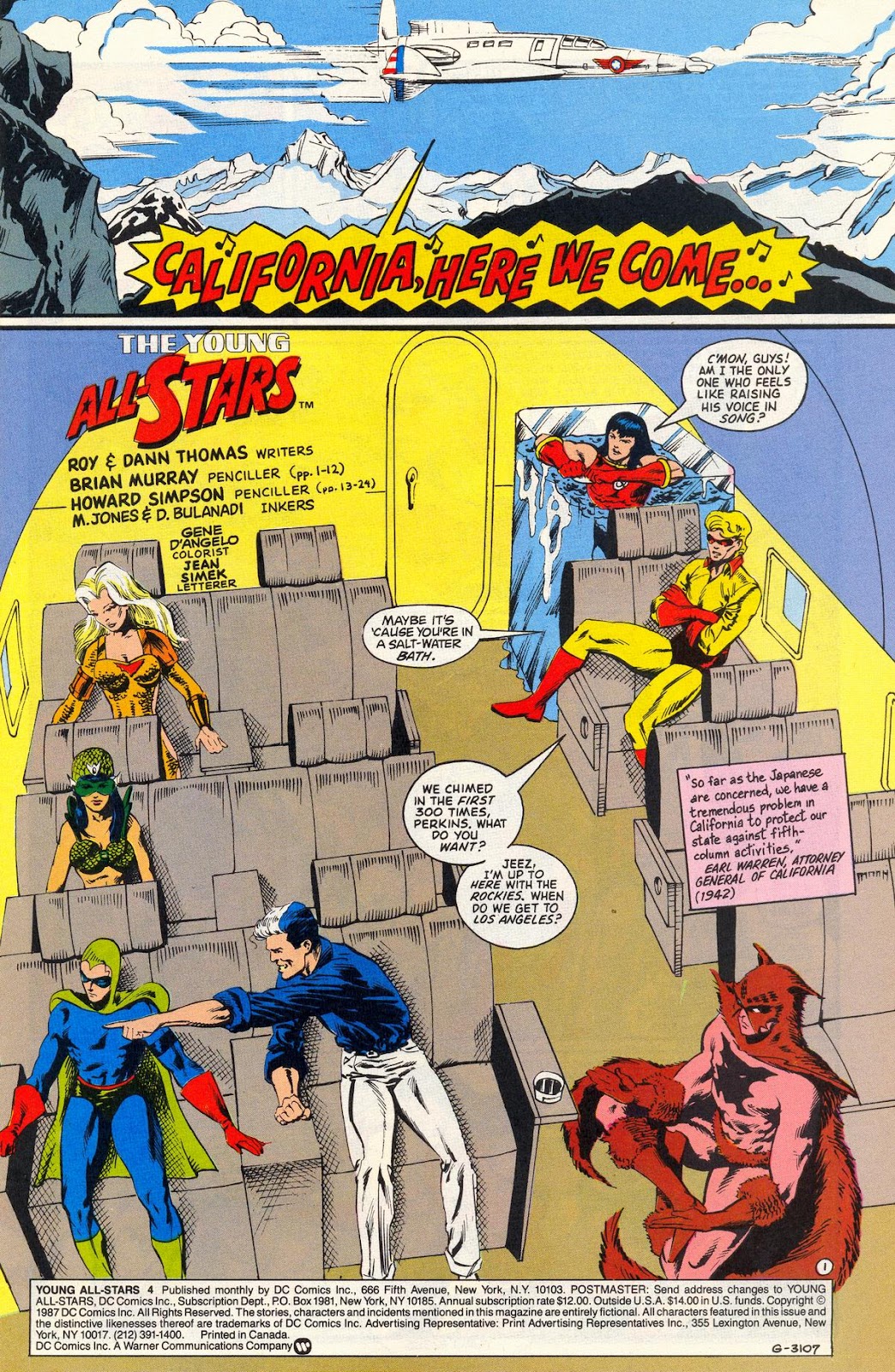 Notice that Flying Fox is sitting in the aisle, "indian style;" that's because he is a Native (First Nations Canadian)! Details folks; can't have a stereotype without the details! This being a team book, and this being Roy, who was weaned on this at Marvel, the group is at each other's throats, especially Sandy. He makes racial insults of both Flying Fox and Tsunami and acts like a general ass to Iron Munro. Fury turns out to be the mother of the group and scolds Sandy into submission, with Arn jumping in to play Dad. Oh, and Tarantula and Firebrand are piloting the plane, as the next page reveals. Guess they learned to fly in between issues, as they have never piloted a plane in any of the previous adventures in All-Star Squadron. They hear the squabbling and Tarantula goes back to the main cabin to make sure they don't tear the plane apart and suggests telling origin stories to get to know one another and so Roy can recap them all... Sandy tells of Sandman coming to tell him of the death of Dian Belmont (didn't happen post-Crisis; but, that appears not to have been officially decided, yet) and teaming up with Sandman, to face some giant bees. Flying Fox relates how Nazis turned up at his tribes (somewhere in Northern Canada) locale, looking for them to join them against the white Canadian government and murdering his father when he refused... 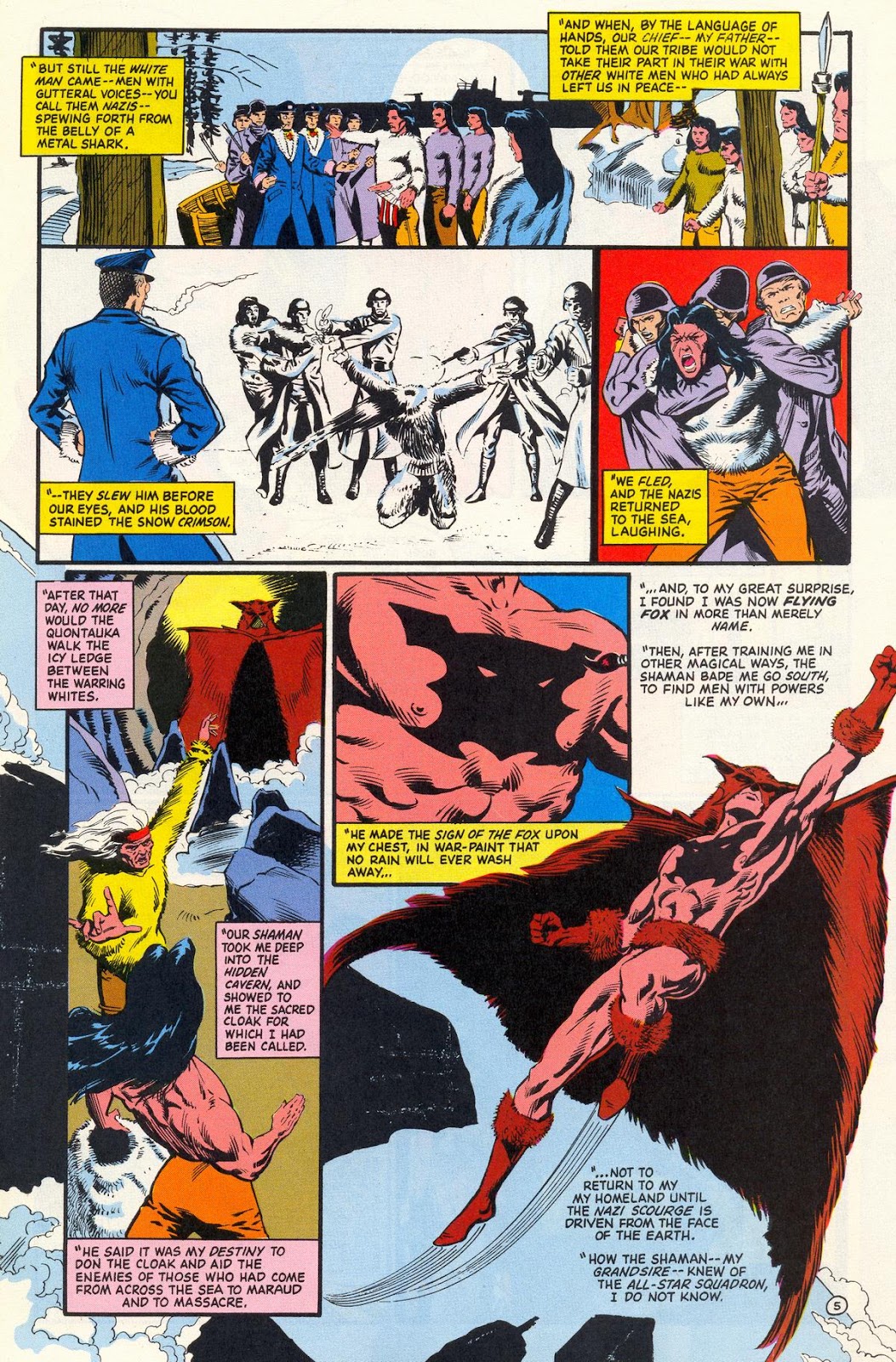 ...His grandfather, the shaman (little S, so as not to get sued), showed him the sacred cloak, taught him some mystical stuff and gave him a permanent fox respray, on his chest and he became the living embodiement of a totem, based on an animal not found in North America. Maybe Canadian foxes pilot gliders or something. Perky and Tsunami give their accounts, next, with Perky being a mutant with webbed hands and feet and requiring to be immersed in salt water and Tsunami tells of racial prejudice in America that led her to beg her parents to send her to Japan, to study. Adm Isoroku Yammamoto, himself, asked her to take part in aquatic experiments that led to her powers, somehow. Yamamoto wanted her to stay in Japan, but Prime Minister and Army general Hideki Tojo insisted she be sent to California, to stir up dissent among the Issei and Nissei. 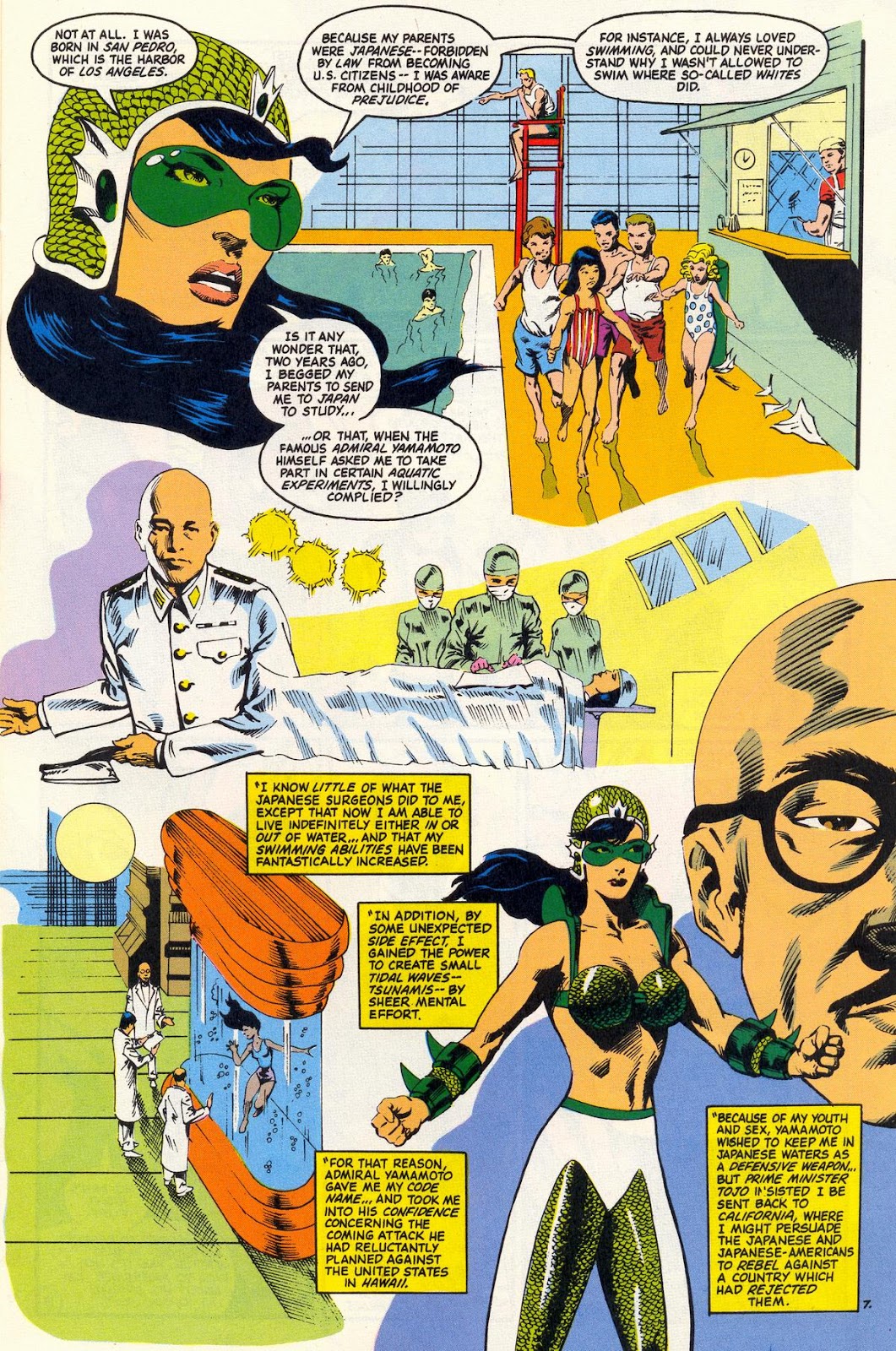 From there, she ran into Perky and the All-Stars and turned babyface. Arn tells everyone that his nickname, "Iron" comes from playing baseball, but that they can all get bent about knowing where his powers come from. Tarantual tells the rest to get over it, when they start whining. Fury recaps Secret Origins #12 and Dan mentions how touching rings gave him and TNT their powers; but, then starts bawling like a little girl, just because he lost his friend and mentor very recently. Get over it kid, that was 3 issues ago! Why, in comic book time that is.....oh, yeah; this is the comic that has spent 5+ years covering 5 months. So, the death was about 3 hours ago, or something. Blubber away kid! The plane hits turbulence and everyone gets dumped onto the starboard side, with Sandy landing in Tsunami's lap, which he doesn't seem to mind (which Perky comments on) and Fury lands in Arn's chest and arms and probably ignites Arn's nickname....if you get my drift. Tarantula returns to the cockpit and Firebrand reveals she pulled the turbulence stunt to knock the kids out of their funk, as they are arriving in Los Angeles. We cut to the War Bond rally, at the Hollywood Bowl (minus Monty Python), where 2nd Lt Ronald Reagan is talking to a crowd of service men and women, while Roy uses the dialogue toe xplain that Reagan used to be married to Jane Wyman and appeared in the film King's Row and was in Special Services, since he wasn't John Garfield or Tyrone Power or Jimmy Stewart. 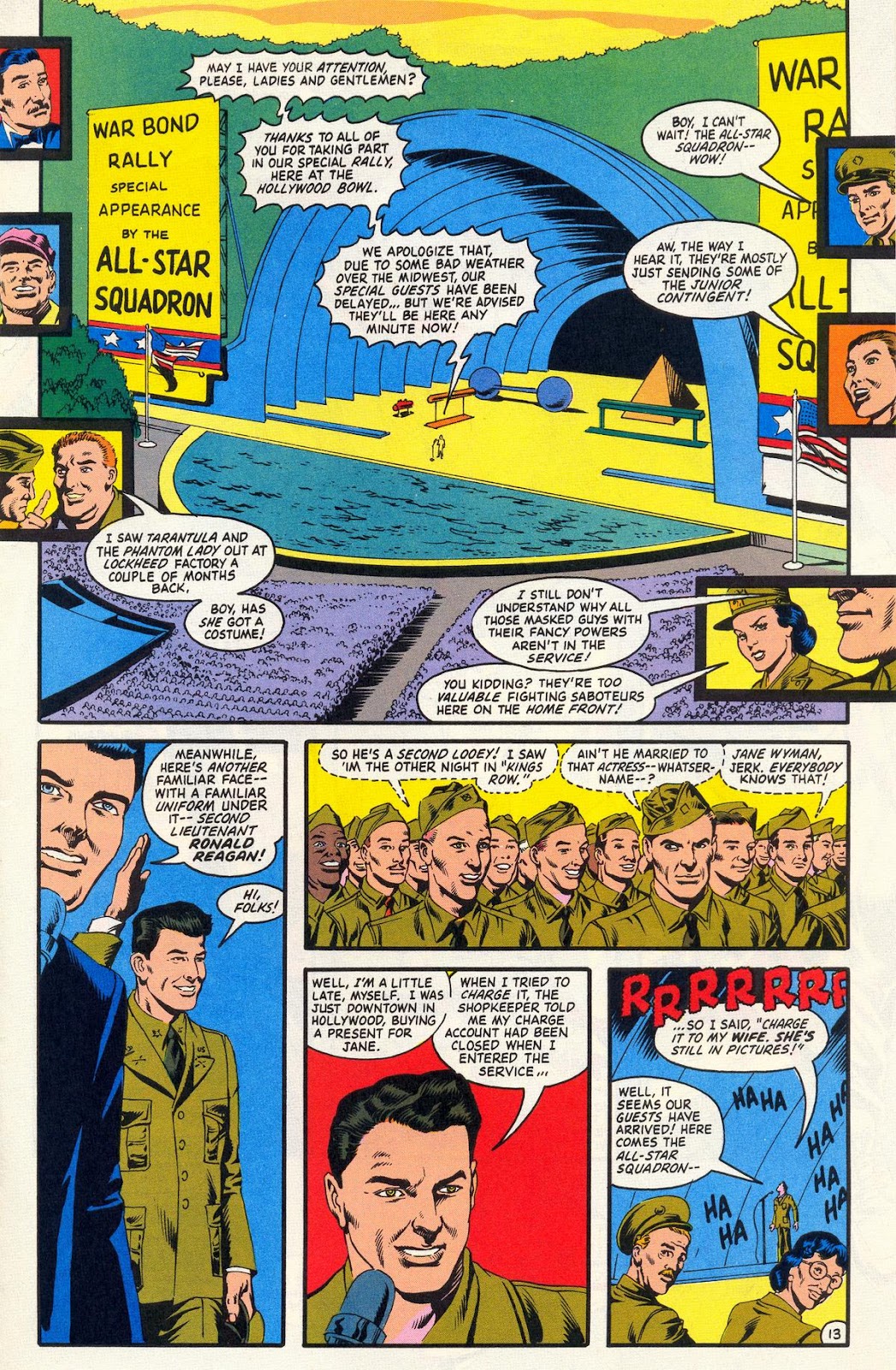 The All-Stars hit the silk, so to speak and make an impressive entrance, while the adults stay in the plane. Some sailors in the crowd notice Tsunami and make some racist comments (civilians, too) and Arn and Fury are snapping at each other, because they are embarrassed about the plane. They toss dyna-Mite and Sandy into the air to demonstrate their strength, where they are caught by Flying Fox, then Perky and Tsunami doe the Esther Williams impression. They do some stunts and we seem them observed from an off-shore U-boat, which houses Axis Amerika and their new Japanese member, Kamikaze (because no one could come up with something different, like, I don't know, something based on Shinto tradition, like Amaterasu, Goddess of the Sun), who looks like he has been raiding Bulletman's wardrobe... 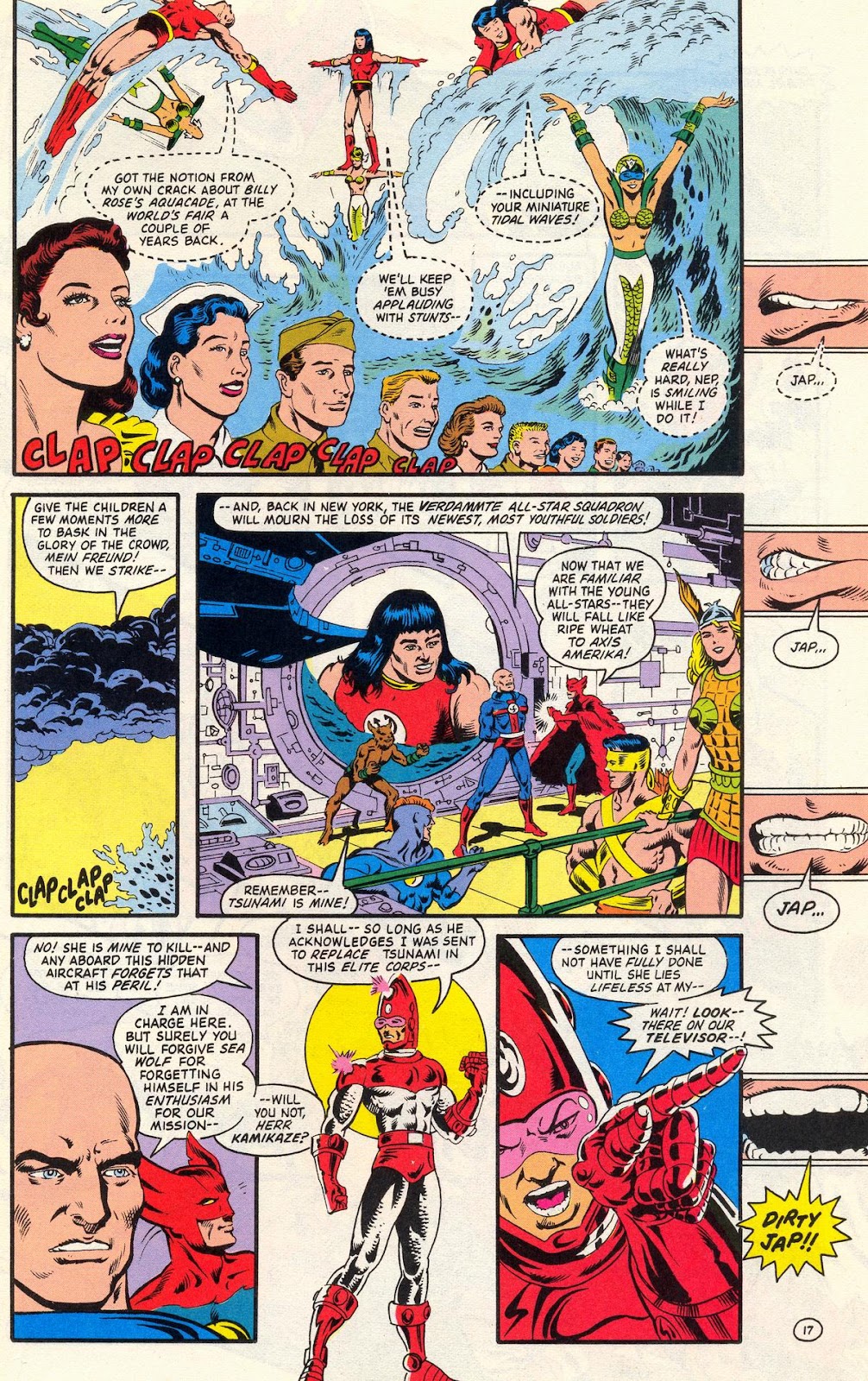 Parts of the crowd are busy with racial slurs directed against Tsunami, which leads to her sending the civilian redneck for a dip and then another getting mad at someone who said he deserved it and it turns into a riot. 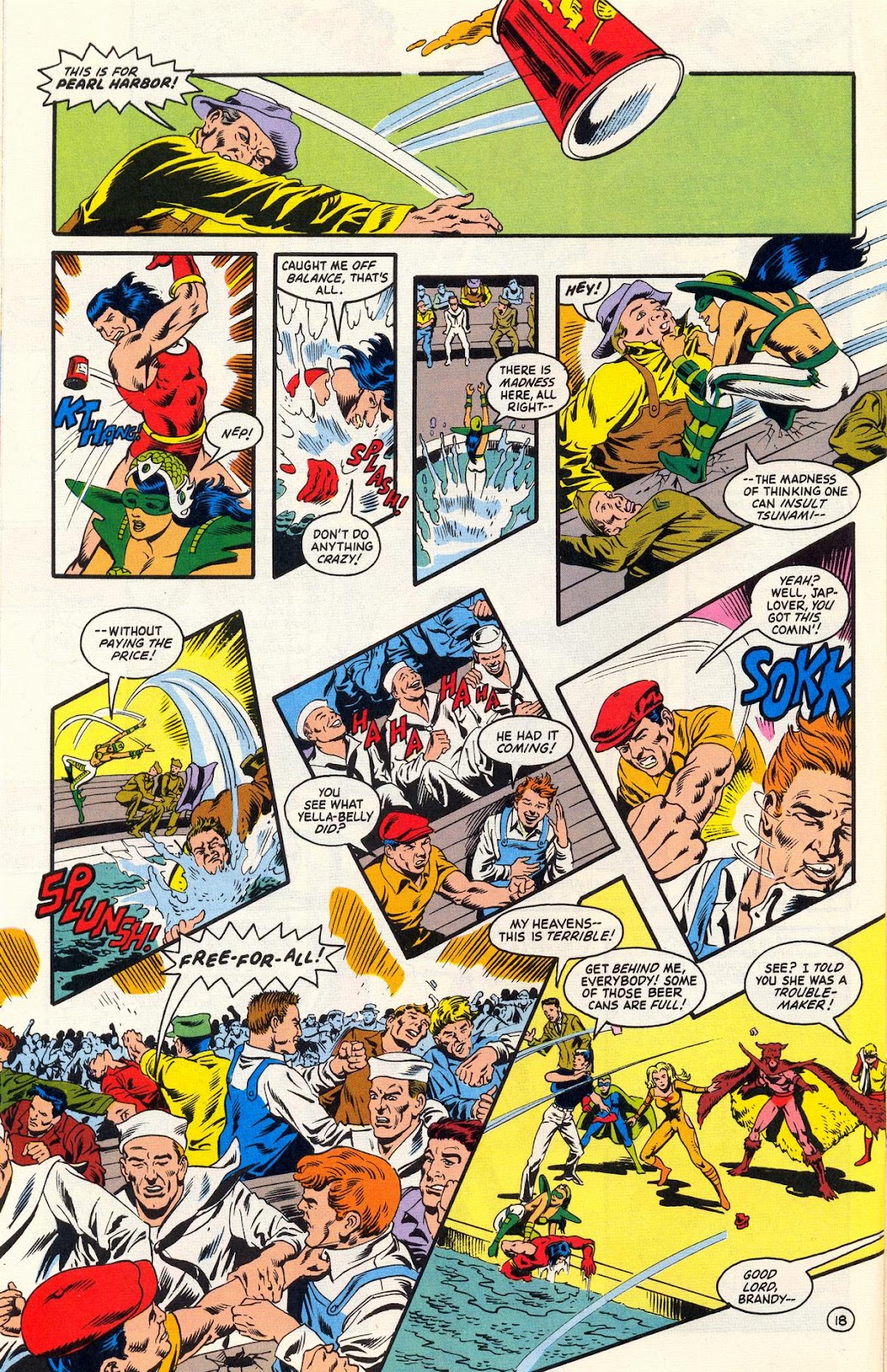 Firebrand gets the crowd's attention and they wrap things off. Ronnie invites them to dinner; but, they decline and decide to see Tsunami's parents (bet I can guess where this is going). AA is still watching and waiting, as they don't to blow their opportunity. They go to San Pedro and find the Shimadas gone, the house sold and covered with racist graffiti. The cab driver has an idea where they might be and takes them to the Santa Anita racetrack, which is a temporary staging center for Japanese-Americans, who are being relocated. There, Tsunami rushes in and sees the fencing and barbed wire, and armed guards... 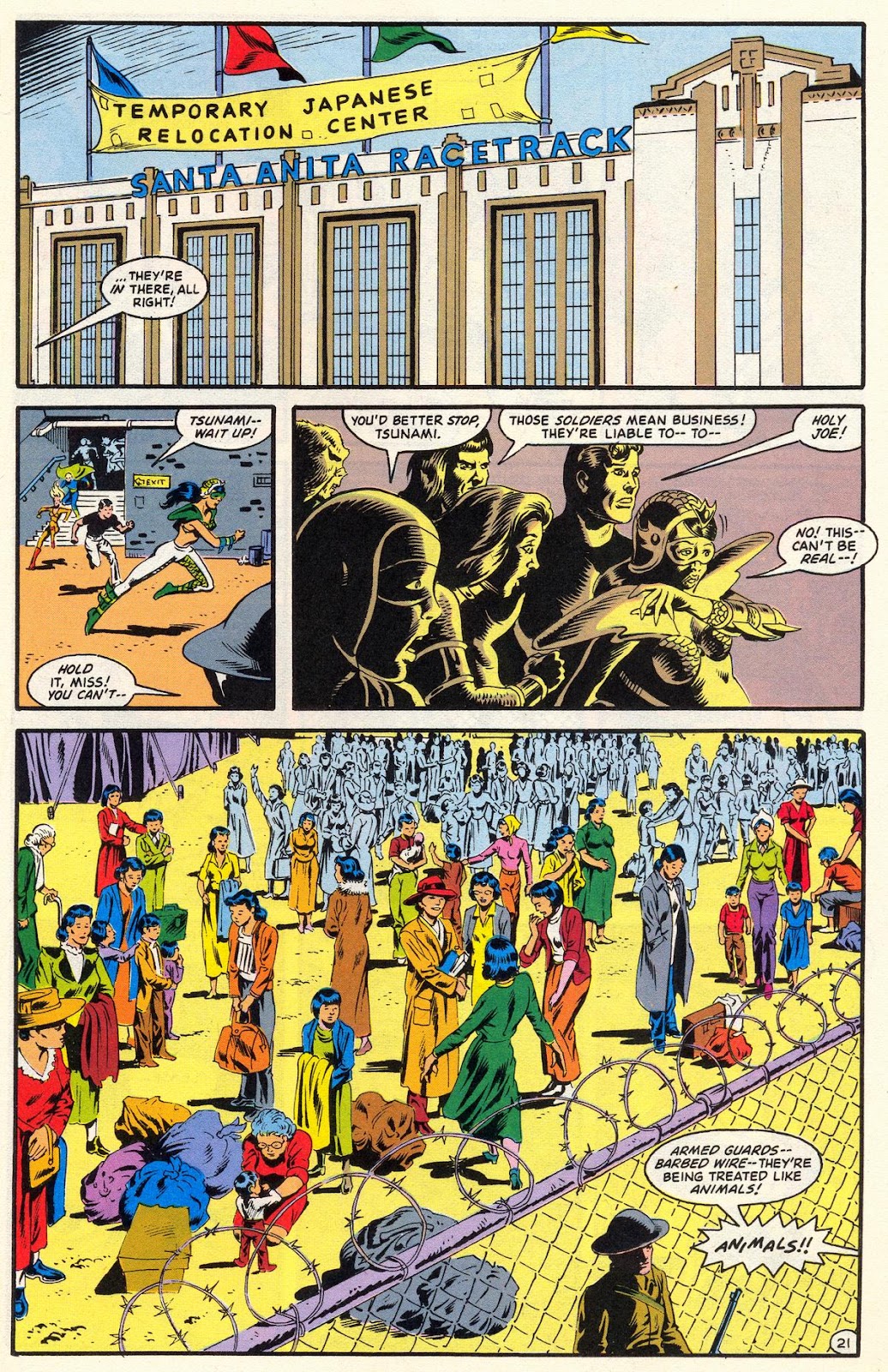 Iron Munro and Fury block her path and the guards are ready to shoot her and Tsunami is ready to go spare. Her mother recognizes her and cries out for her to run away. The others try to convince her to go; but, she strips off her costume and walks, naked, through the gates to join the others (who quickly cover her). She gives a last threat that if her brother or father is harmed, America will learn what fear truly is. Thoughts: More stage-setting stuff, as Roy is now turning the characters in a group, giving them opportunities to bond, as a team, and a common enemy. In this instance, they must deal with internal prejudices, then face outside ones, while also introducing readers of the 80s to the reality of the internment of Japanese-Americans, who were denied rights of citizenship, under racist immigration laws, all of which was unconstitutional, particularly in the case of the Nissei, who were born in the country. The art is improving, though both young artists struggle with consistency. Of course, we have 4 artists involved in this, with two sets of pencilers and inkers. Still a bit light on personalities, aside from stock responses. Dyna-Mite is grieving and Roy hints he will undergo some kind of change, on the letters page. Arn is a reluctant hero, who wants nothing to do with costumes and code names and continues the mystery of the origin of his powers. Fury's origin page recounts the Furies of myth, which continues to suggest that Helena Kostmatos does not control Fury. We learn more about Flying Fox; but, it is typical cliched and rather culturally insensitive stuff. Adding Nazis to it doesn't do much to differentiate it from previous Native heroes, who were almost always stereotypes of Native warriors and lore, from a white perspective. Sad to think that the only comic book out there, at this time, that presented a sensitive portrayal of a Native American (as in North or South America) is a post-apocalyptic action/adventure series about an Apache fighting the 4 Monsters of ancient lore. Somebody should review that series.  Things are developing and Roy is keeping my interests; but, the cliched aspects are a bit of a disappointment to me. Roy was a pretty creative force, at Marvel, and helped shake off some of those cliches and stereotypes from Stan's generation; but, now he is the "establishment," rather than the Young Turk. For me, a lot of his work in this period kind of reflects that, as it is well written and professional, yet somewhat out of step with the zeitgeist. Some of his peers went through similar issues, as Marv ran into writers block, after several years of great work on the Titans and the massive story of Crisis; Jim Starlin was not exactly telling epic stories in Batman (and perpetuated a lot of stereotypes there, with Shiite terrorists and Soviet assassins) and Len Wein was pretty much just editing. Maybe it was just the whole "passing of the torch" generational shake-up that was going on, much as it had when the Bronze Age dawned. Historical Notes: After the issuing of Executive Order 9066, authorizing the detention of Japanese-Americans, the Santa Anita Race Track, along with the Los Angeles County Fairgounds (in Pomona) was designated as a detention center for Southern California. In a typical movement, that would make Orwell proud, the race track was renamed the Santa Anita Assembly Center, which sound far less foreboding than Prison or Concentration Camp. Initially, horse stables were converted to living quarters (hopefully with the contents of the previous occupants removed and thoroughly cleaned) and then 500 barracks were built to house prisoners ("detainees" just sounds too genteel). At its peak, over 18,000 people were hed there, before being moved to permanent camps, in other states, including Wyoming, Arkansas, and Colorado, as well as Manzanar and Tulelake, within California.   War Bond rallies became a common feature of the Home Front, throughout the war. Hollywood celebrities, as well as returned war heroes, like the crew of the Memphis belle and Medal of Honor winner John Baselone, were common sights at such things. The Hollywood Bowl played host to several fundraisers, including this 1944 extravaganza, for the USAAF....  Hollywood celebrities engaged in various functions for both fundraising and morale efforts, such as the Stagedoor Canteen, where celebrities served and entertained servicemen and women, as well as charity apeparances, special broadcasts and films, etc. Ronald Reagan was an actual 2nd Lt, having served in the Army Reserve since 1937. In April 1942, he was called to active duty, though he was not yet involved in public relations and military movies, at the time of this issue. August 1945: On August 1, Winston Churchill entered the house of Commons for the first time, as the ex-Prime minister and is treated to a round of "For He's a Jolly Good Fellow," from Conservatives, as well as "The Red Flag," from Labor. On Aug 2, the USAAF launches its heaviest raid of the war, as it drops 6,000 tons of incendiary bombs on Tokyo (from 800 planes), killing more than 80,000 people. On August 3, it completes operations mining all significant harbors of Japan and Korea and the US government announces that Japan is completely blockaded. On August 5, the USAAF drops over 700,000 leaflets over Japanese cities, calling on them to surrender or face devastation. The US and the Allies have rejected all overtures from the Japanese government for a negotiated surrender or just one that allows the Emperor to retain his position. On August 6, the B-29 Enola Gay, commanded by Col Paul Tibbets, takes off from its base on Tinian, carrying a Top Secret payload. Tibbets had ben briefed on his mission on August 2, on Guam, by Gen Curtis LeMay. On the 4th, he briefed his crew, in general terms, mentioning powerful bombs unlike any seen before, but without specifics. His crew took off, along with two other B-29s, Great Artiste, which carried instruments to measure the effects of the new weapons, and the later-named Necessary Evil, which was to make a photo record. They flew 6 hours to their target, selected because it was a major embarkation point, a major military base, had an area larger than 3 miles in diameter and was important industrial and military locale. Their target had sounded an alert as bomber flew over on their way to attack other targets. The all clear was sounded, just after midnight, on Aug 6. At around 7:00 am, an alert was sounded again as a B-29, Straight Flush, flew over the city and radioed a report to Enola Gay about the cloud cover, saying "Cloud cover less than 3/10th at all altitudes. Advice: bomb primary." The all-clear sounded again, after they departed. At 8:09, Col Tibbets started his bombing run and turned his controls over to the bombadier, Maj Thomas Farabee. At 8:15, Farabee dropped the weapon, a single bomb, code named "Little Boy". The bomb fell for 44 seconds, from 31,000 feet to 1900 ft above the city. The aiming point was the Aioi Bridge, but a crosswind missed the bridge, by 800 feet and it detonated over the Shima Surgical Clinic, releasing the equivalent of 16 tons (plus or minus 2) of TNT. On the ground, there was a brilliant flash of light and a loud boom, followed by a shockwave and firestorm that killed 70-80,000 people outright (1/3 of the population of the city) and injured another 70,000. An estimated 20,000 of the dead were military personnel, the rest civilians: men, women and children. Over 90% of the doctors and 93% of the nurses in Hiroshima, the target city, were killed in the blast, leaving few to treat the survivors and the wounded and dying. The firestorm that erupted burned everything within a 2 mile radius of the blast.  The city was cut off from communication with the rest of Japan. A control operator at the Japanese Broadcasting Corporation noticed that Hiroshima had gone off the air and tried to re-establish contact and failed to get through on phone lines. The Imperial Japanese Army lost all contact with military units in Hiroshima and telegraph lines were not working from the city. Slowly, reports came from rail stations, with rumors of an explosion. An officer was dispatched to make an aerial survey of the damage to the city, assuming an Allied air attack. After flying 3 hours and still 160 km from the city, the pilot observed intense smoke from the firestrom. After circling to survey the destruction, the aircraft landed and reported back to Tokyo, then the officer began helping to organize relief efforts. 16 hours later, President Truman went on radio and announced that the US had dropped an Atomic Bomb on Hiroshima, revealing it to the public and the world. The horror of the weapon and its aftermath is the stuff of nightmares. Shockwaves flattened buildings and fire enveloped others, with the majority consisting of wood and paper. Some reinforced concrete structures survived. The dead were often charred remains, with stories of shadows burned into walls. Survivor were often badly burned and died of related infections, as well as radiation poisoning, depending on their location, relative to the epicenter. The Japanese government clamped a lid on the aftermath, with complete censorship of the destruction and death; but, rumors spread. President Truman's speech told Japan that failure to surrender unconditionally would bring a rain of such bombs on the country, followed by sea and land forces of unimaginable size. Stations on Saipan broadcast similar messages too Japan, every 15 minutes, revealing the destruction of Hiroshima and urging residents to leave cities. The JBC eventually broadcast that Hiroshima had been destroyed by a single Allied bomb. On August 7, Japanese atomic scientists entered the city to survey the damage and confirmed tot he government, in Tokyo that the weapon was an actual nuclear device. Adm Soemu Toyoda, Chief of the Naval General Staff, estimated that only one or two more bombs could have been prepared in the timeframe and it was decided that Japan would not surrender and would endure further attacks. American codebreakers intercepted the transmissions and reported to their superiors. A second wepaon would be ready by the 11th, but Tibbets brought up weather conditions and asked if it could be pushed up to the 9th. On August 8th, the Soviet Union, after notifying Japan that it was voiding their neutrality pact, declared war on Japan. Meanwhile, in Germany, the Nuremburg charter was issued, l;aying out the guidelines and legal aspects for the Nuremburg Trials, to follow. On August 9, Soviet troops poured across the border into Manchuria. The Japanese had been watching for troop buildups but greatly under-estimated the forces arrayed against them. Meanwhile, on Tinian, the B-29 Bockscar, commanded by Maj Charles Sweeney, took off with the weapon known as "Fat Man", bound for their target of Kokura. However, take-off delays and rendezvous delays had allowed smoke from firestorms in Yahata and coal smoke from industries in Kokura to obscure the target and the aircraft switched to its secondary target, the seaport of Nagasaki, which had largely been untouched by bombing, due to terrain making it difficult to identify via radar. At approx 07:50, an alert was sounded, but soon followed by an all-clear, after only 2 B-29s were spotted, assuming they were a reconnaissance mission. The aircraft Great Artiste dropped 3 instrument packages, via parachute, including one with a letter to Prof Ryokichi Sagane, of the Univ of Tokyo, who had studied with Manhattan Project scientists at Berkley, urging him to inform the government of the dangers of weapons of mass destruction. The message was eventually found by military authorities but not delivered to the professor until a month later. At 11:01 local time, a cloud break allowed for visual sighting of the target and Fat Man was released, with a 5 kg core of plutonium and detonated 47 seconds later, at a height of 1650 ft, above a tennis court. A force equivalent to 21 tons (plus or minus 2) of TNT was unleashed on the city, though a firestorm as experienced in Hiroshima did not ensue, as there wasn't sufficient fuel for such fires. The hills of the Urakami Valley helped contain the effects of the blast, but estimates are between 22,000 and 75,000 immediate deaths, with final related deaths between 39 and 80,000. The confusion was based on undocumented foreign workers and conscripts in plants. Further weapons were being prepared and 2 more Fat Man type weapons were readied to be ferried to Tinian, on Aug 11 and 14. The Japanese War Council met, but could not come to a decision. They were later informed that Emperor Hirohito wished a conference and signaled that he was willing to surrender to the Allies, so long as the throne was preserved. Debate continued. August 10, the Chinese Civil War recommenced, as Communist and Nationalist forces resumed hostilities, which would ultimately end in victor for Mao Tes-Tung and the Communists, as Chiang Kai-Sheck and his Nationalist government fled to Formosa, to establish what would become the Chinese Republic (Taipei). Meanwhile, the Japanese delivered a message to the Allies, announcing their willingness to surrender, on the terms that the Emperor be retained. August 11 saw the Soviet Union launch the invasion of the island of Sakhalin, territory lost in the Russo-Japanese War. US Sec of State James Byrnes rejected Japan's offer and restated the Allied position of "unconditional surrender." August 12 found Soviet forces advancing down the Korean Peninsula, swiftly overwhelming Japanese forces. The US Government released the Smyth Report, outlining the development of the Atomic Bomb. On August 14, Emperor Hirohito accepts the Postdam Declaration and secretly records his announcement of his surrender tot he Allies, in very formal courtly Japanese. meanwhile, a plot to occupy the the Imperial palace and steal the recording fell apart and the leaders committed seppuku, ritual suicide. at 19:00 hours, President Truman announces the Surrender of Japan. August 15, the Emperor's recording is broadcast across Japan, marking the first time most Japanese ever heard his voice. It does not mention surrender and is not immediately understood by the general public. The day is declared VJ Day.  In Vietnam, the Viet Minh rise up against French colonial rule, while Korea is now technically free from Japan. By August 30, the Viet Minh occupy Hanoi and the country is split between North and South Vietnam. On August 18, the Soviets abide by their agreement and halt their advance at the 38th Parallel, in Korea, despite having the forces to take the entire country. They occupy Pyongyang and set up a provisional government. US forces would land at Inchon, in September and take control of the South. On August 17, new prime minister Prince Naruhiko Higashikuni orders all Imperial Japanese forces to obey the Emperor's order and lay down their arms. The Soviets continue their advances on former territory, retaking the Kuril Islands and Maoka. On August 21, President Truman ends the Lend-Lease Program, causing a financial crisis in the UK, as it did much to offset the financial burden of the war, as the UK seeks to rebuild and re-establish control of its colonies. On that same day, Japanese forces in Hunan surrender formally to the Chinese. August 28 sees the Occupation of Japan begin. Japanese officials landed in Manila on August 19 to meet with Gen MacArthur, to discuss the terms of surrender. On the 28th, the first Allied personnel landed, by plane, in Atsugi. They were followed by the USS Missouri (BB-63), which landed the 4th Marine Regiment. They were then followed by the 11th Airborne Division, which landed at Atsuki Airdrome. Additional forces followed. On August 30, General MacArthur landed in Tokyo and issued new decrees related to Allied conduct and the flying of the Japanese Honimaru flag. More decrees would follow and the Formal Surrender of Japan was set for September 2. World War 2 was now, effectively, over. Now came the rebuilding and the wars of independence, as European colonies decided it was time that they had their freedom, as new nations would emerge and join the Old World in the new United Nations.
|
|
|
|
Post by codystarbuck on May 9, 2021 17:29:06 GMT -5
Young All-Stars #5 Fury gets the cover spot. I know it is a design thing; but, it's rather disingenuous to feature characters on the cover who do not appear in the story. The only person on that cover featured inside is Fury. If you ask me, it doesn't help sell your new group of characters by reminding us they are not the more established ones. Creative Team: Roy & Dann Thomas-writers, Brian Murray (almost wrote Bill) & Howard Simpson-pencils, Malcolm Jones III, Bob Downes & Alfredo Alcala-inks, Jean Simek-letters, Shelley Eiber-colors. Man, is this a comic book or an employment project! Synopsis: When we last left, the Young All-Stars had wowed a crowd at a war bond drive event, then sparked a riot and Tsunami had joined her mother in a temporary internment camp, at the Santa Anita Racetrack. We pick things up at the Hollywood Canteen... 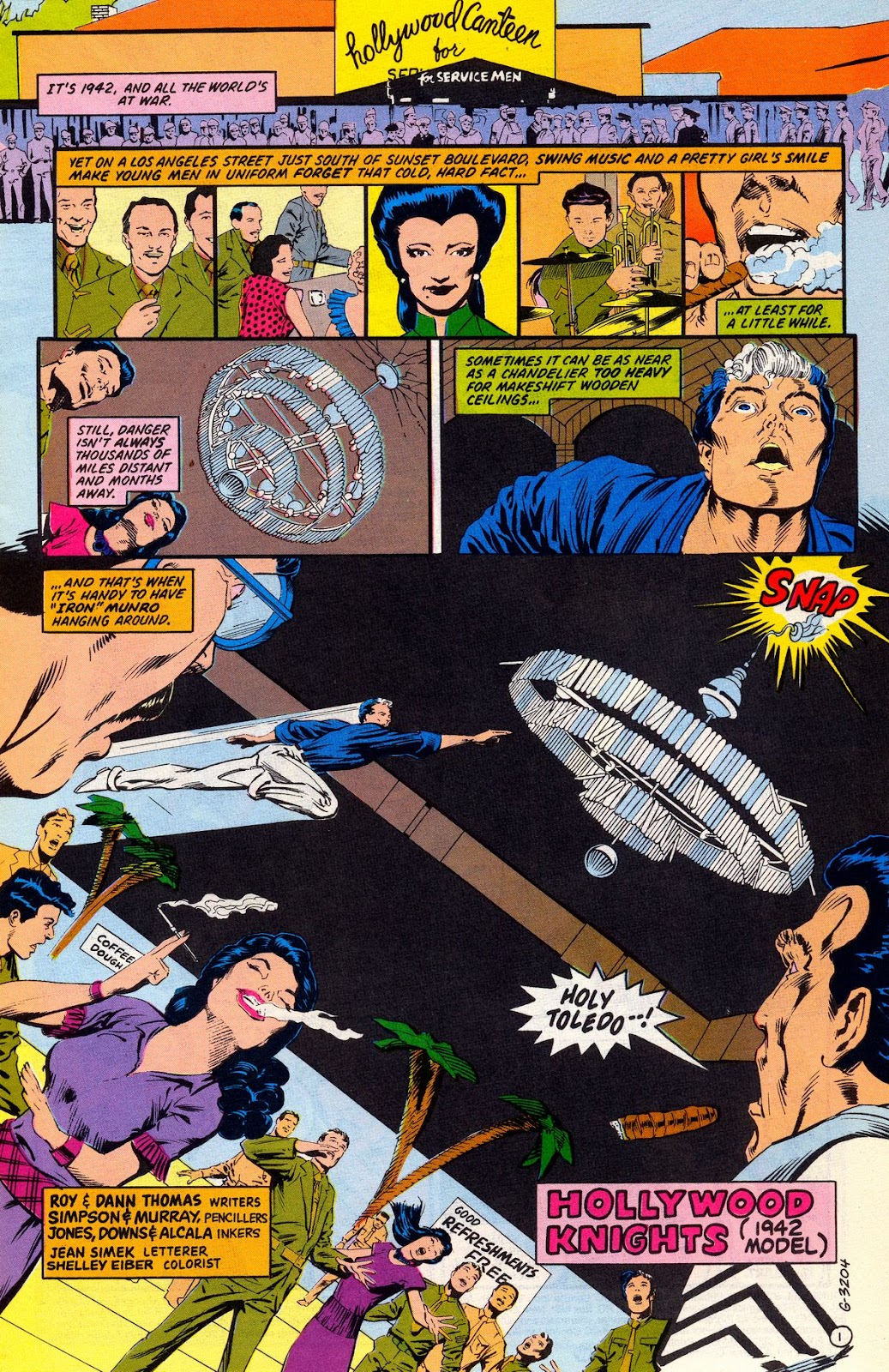 A chandelier is crashing down and Iron Munro leaps to catch it....er, smash into it and saves the day. Dyna-Mite is impressed and sucking up to him and ignores the fact that Fury could have done the same thing, but she's a girl and they don't count. Everybody moves on and Fury huffs away, while Firebrand and Tarantula cut a rug. Arn tries to cool things off and asks Fury to dance but gets rejected in favor of a soldier. Gotta have a uniform, dude. Sandy makes some more racist remarks about Tsunami and Neptune Perkins threatens to put him over his knee. It pretty much ends with Perky saying he is headed back to Santa barbara, in the morning and Sandy stomping off, leaving Dan to whine. Arn and Flying Fox talk, though Fox sounds like Tonto. White man's ways are strange to me, kemo sabe. Arn goes off for some fresh air, plows into a soldier and then tries to pick a fight until he notices that the guy only has one arm. He apologizes and asks how it happened. 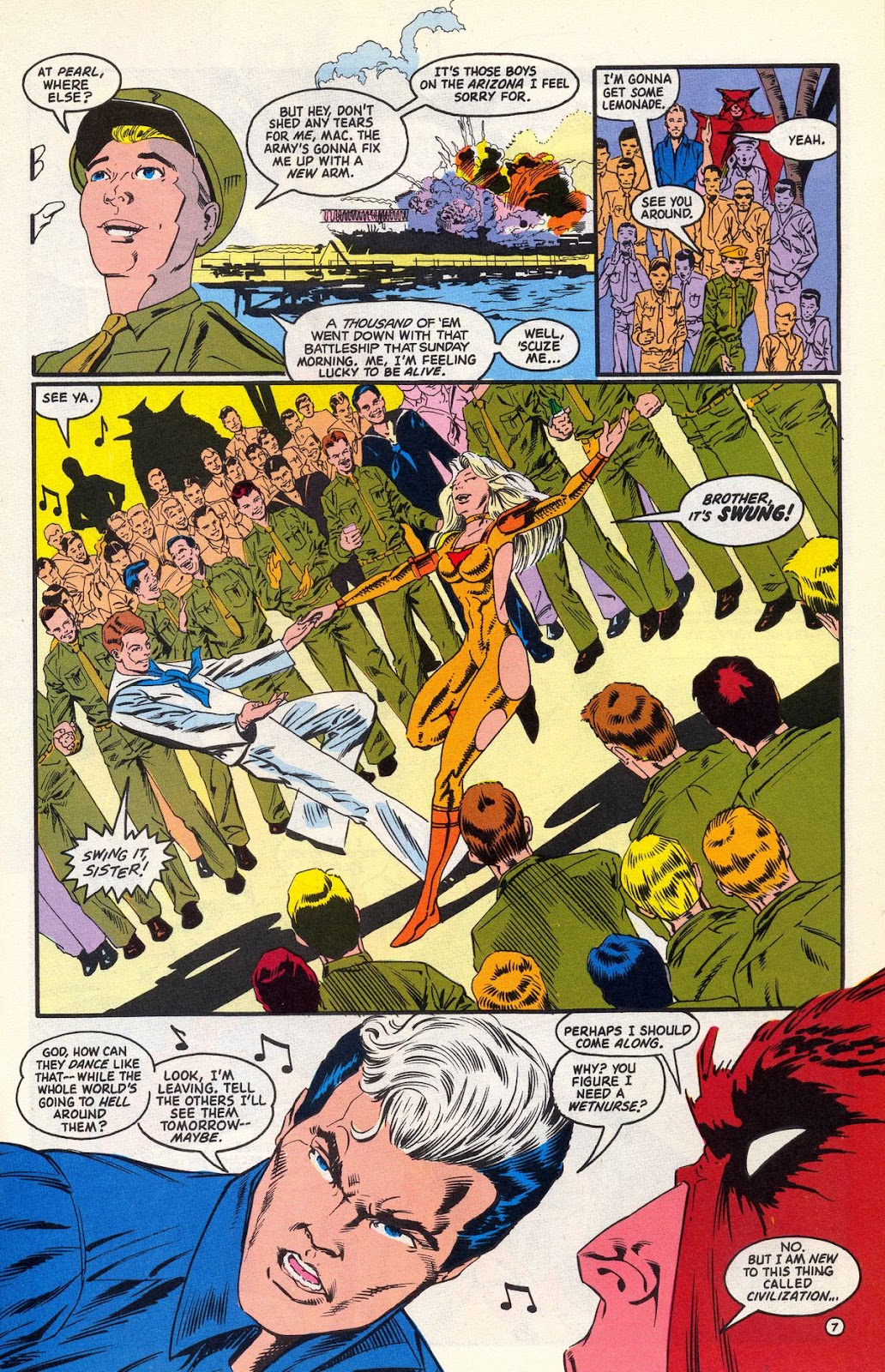 He lost it at Pearl and witnessed the explosion of the USS Arizona. He is happy to be alive. Arn can't understand how people can dance and leaves. It's simple; they are going off to war, probably to die, and just want to have one moment of life, before they enter a world of death and destruction. Eat, drink and be merry, for tomorrow we die! Arn leaves and Fox tags along. Dyna-Mite sees something is bothering him and asks Fury to go with him to see what's up. She is reluctant but does it for Dan. Arn and Fox encounter a zoot suiter and an Army recruiter and Arn wants to take him up on joinging the service, but has to prove he is 18. He isn't, has no license or draft card and decides to lift a car to show off and balances it badly, causing it to crash back down on another car. said car's owner comes out to address the situation, with his fists and pretty much breaks one trying to punch Arn. A cop turns up and suddenly Arn is removed from the situation. Fox has illusion-casting powers and altered the situation, in the eyes of the cop and crowd... 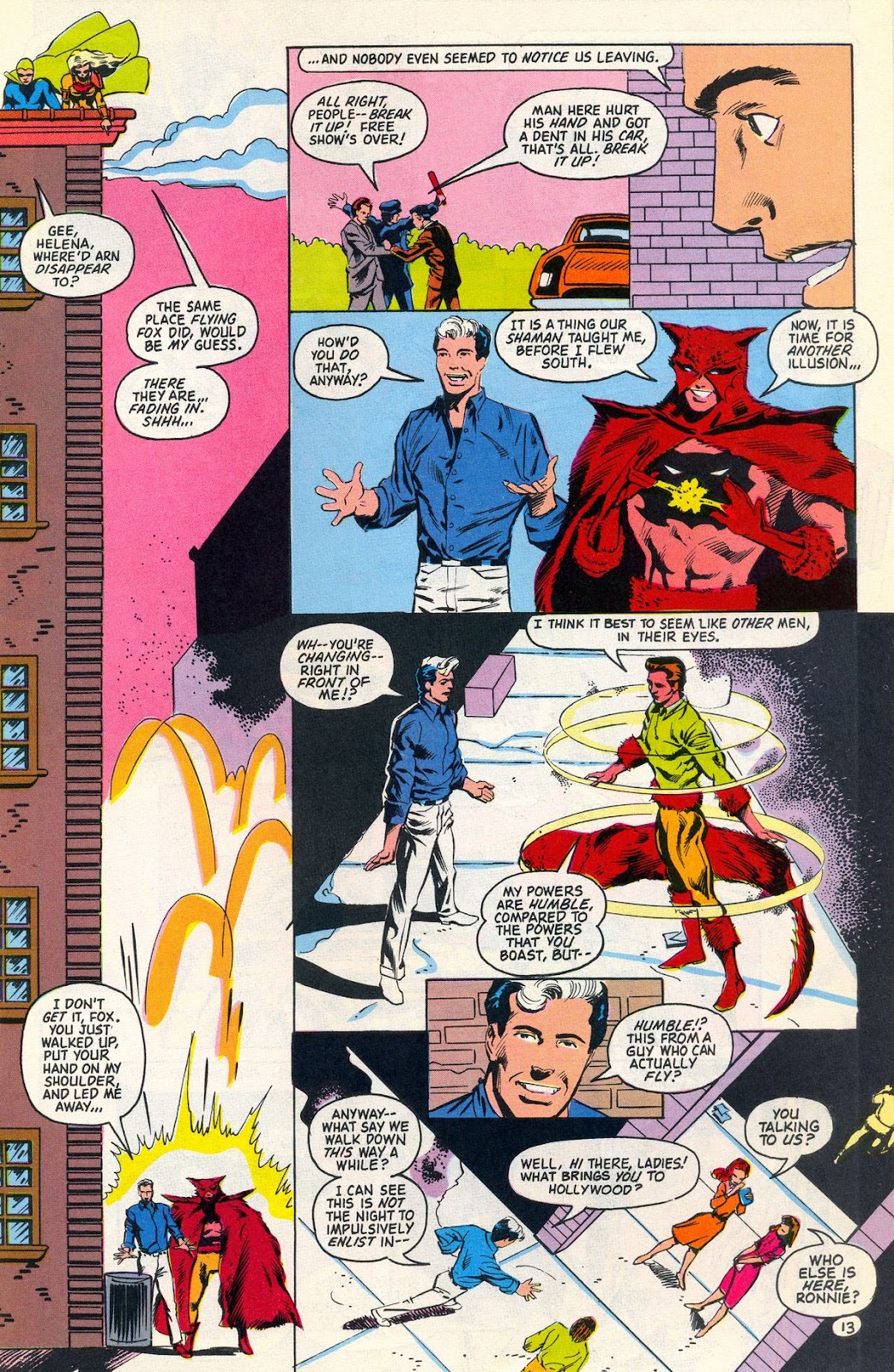 He changes into civilian attire and they head on down Sunset, where they meet a couple of ladies, who ask if they want to go for a ride. Um, that usually involves payment, guys, especially in that area. They go to the Santa Monica Pier and the amusement park, but it is closed, because of the blackout regulations. One of the girls, Betty, is a spoiled brat and whines about the war interrupting her fun and Arn leaps with her over the fence, to go have some fun. Said fun consists of making out (and then some) under the pier. "Fred", aka Flying Fox, is left with Ronnie and she overhears Arn telly Betty that they are trainees with the All-Star Squadron and asks "Fred" about it. Fox removes the illusion of his civies and takes her flying. They go up to the top of the ferris wheel to look out over the bay and the moonlight, when they are interrupted by Bullet Head, aka Kamikaze. 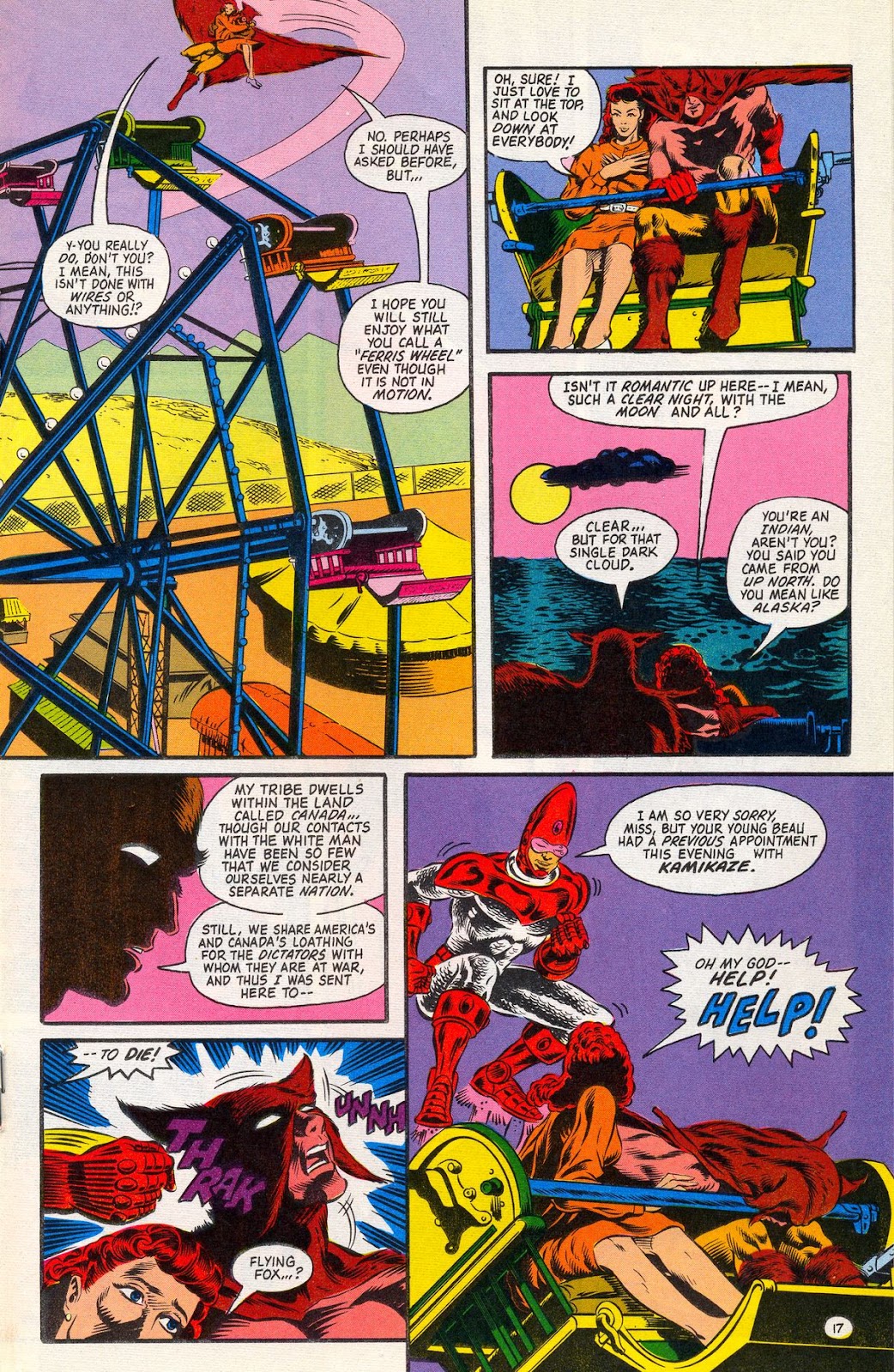 Arn zips his pants and jumps in to defend and tussles with Kamikaze and gets hit from behind by Ubermensch. Fury hops the fence and runs to the fight while Dan is stuck outside, as he is too wussy to climb a chainlink fence. Cape would hinder that, though. Fury catches the falling Arn and both end up in the bay, while Betty runs into Gudra. Axis Amerika leaves with the unconscious Arn, Fox and Fury, while Dyna-Mite looks on. Dan tries to help and is enraged when he notices the pegasus horse and throws a drop kick at Uber's back. 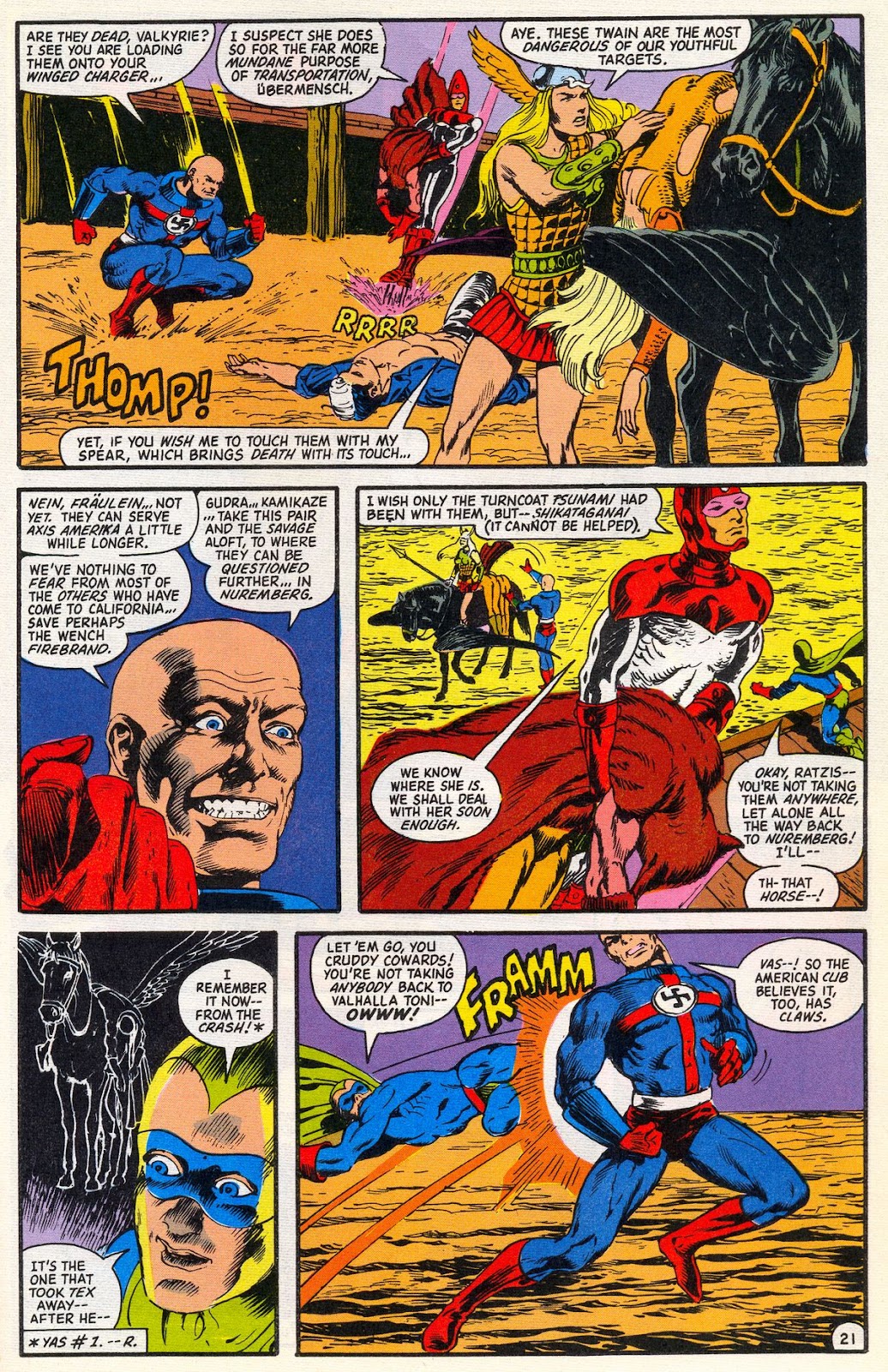 It has no effect and Uber insults Dan by ignoring him and moving on. Dan gives him a swift kick in the Unter and ticks off the Ratzi, who backhands him into a piling and knocks him silly. he tells him to send a message to the rest of the All-Stars to face them at Santa Catalina. The Axis then take their prisoners to their airship HQ, the Nuremburg... 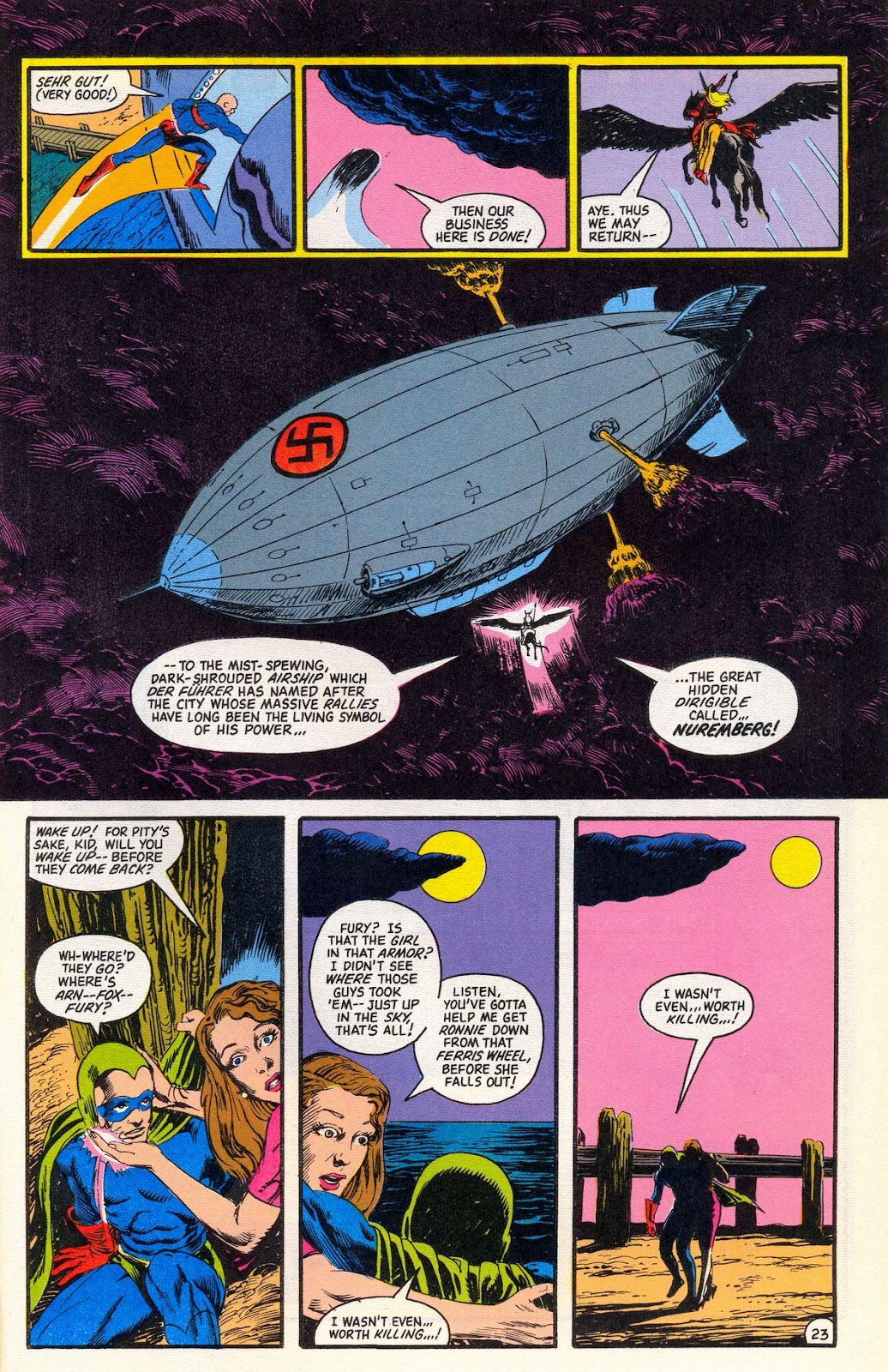 Betty wakes up Dan and tells him she needs his help to get Ronnie down from the ferris wheel. He just whines about not being important enough to kil. There follows an interlude of Tsunami at the camp... 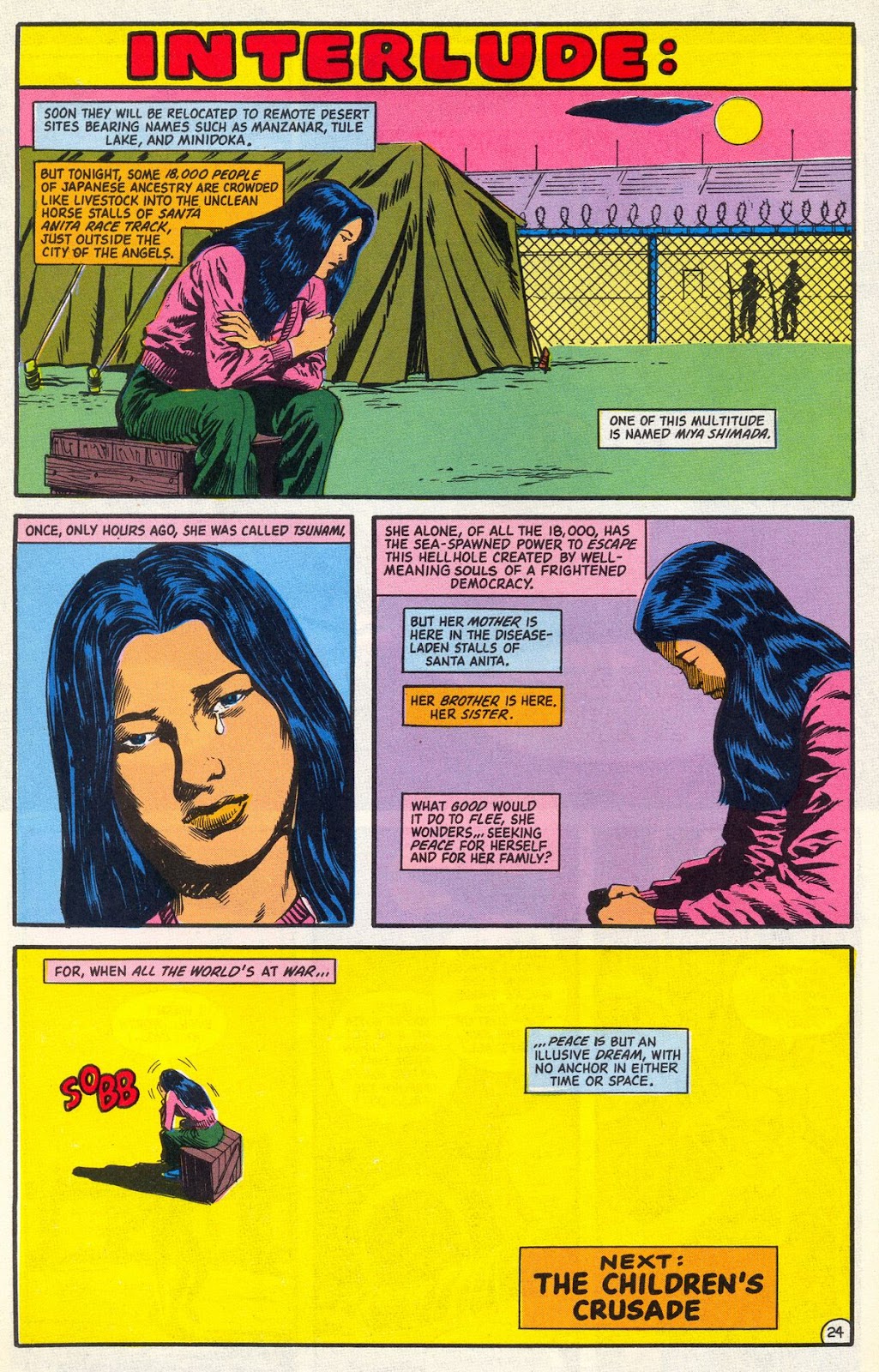 Thoughts: Thoughts: So, Roy brings us some more WW2 Los Angeles history, as we get to see the Hollywood canteen, minus the celebrities, though the matron is supposed to be one, I think. I don't recognize a likeness and they don't name her. Unfortunately, this series and the latter days of the All-Star Squadron were not blessed with gifted caricaturists. More in a moment. More conflict this issue, as we see more and more that Arn Munro is a bit of a self-absorbed jerk and Fury is getting a bit ticked off about the sexist attitudes. That has more at play, as will be revealed later. It doesn't take a genius to see that Arn and Fury are probably destined to be an item, since by the usual Hollywood standards, if they are that antagonistic they must be secretly attracted to one another. Dan continues his "poor little me" bit, though that at least feels organic. He just lost his friend and mentor and there is a lot of grieving there. He also lost his powers; so, obviously, he is being set up to gain new ones. That's the problem of too may years of comic book story conventions; you can see the plot twist coming. I really, really hate the way Fox is being written. Roy says his tribe has had little contact with the white man and Canada is a big place, with a sparser population than the US; but, come on, this is 1942. You're telling me that they remained apart from white society until the Nazis turned up? Nope, not buying it. Roy wants to have an outsider character and an ethnic one, to boot; but, that means he is reduced to writing him in a stereotypical fashion. At least he isn't given broken English dialogue; but, it just seems like the same stereotypical take, with better dialogue. It's insulting in a book that was published in 1987, even set in 1942. Just a cursory review of information of the First Nations of Canada showed there was widespread trading across the continent by the groups, before the europeans, which then brought them into contact with the Europeans when they started exploring and trading. Laws designed to assimilate the First Nations into white society led to schools and appropriation of land, making it that much more unlikely that Fox's people remained isolated. Even the Inuit groups came into regular contact with whites. First Nations people served in large numbers in both World Wars. Don't get me started on a native character being colored red (or an Asian yellow or orange) in a comic, in 1987. This isn't Barsoom. The artwork looks good, until we get to the Santa Monica locale and then it turns very amateurish. No page divisions are listed for the artists; so, no telling where the problem lay. It actually looks kind of like what you might find in a 1942 comic book; but, I don't think that was by design (as opposed to when Richard Howell drew issues of All-Star Squadron). That same artist renders the Nuremburg, which looks more Goodyear Blimp than Hindenburg. The zeppelins had longer structures and the art (forced perspective notwithstanding) is more football shaped. The art also shows it venting something, which I think is supposed to be its smokescreen/cloud cover. Kind of makes it look like it needs some Beano. Roy's interlude kind of gets its history a bit wrong. Roy says there are 18,000 there; but, the center was just opened up, at the time of the story and only reached the population of 18,000 at its height. It was operated through October 1942 and this is April, just as the first groups of families were being rounded up and herded there. Roy is trying for an emotional response, which the greater number aids. Don't exactly care for that approach, from a historical perspective. Had he said there would soon be 18,000 living there, it wouldn't bother me as much. The letters page features the announcement of the passing of Wayne Boring, Superman artist of the Golden Age. He also gives a guide to the celebrities we were supposed to be seeing in All-Star Squadron #66 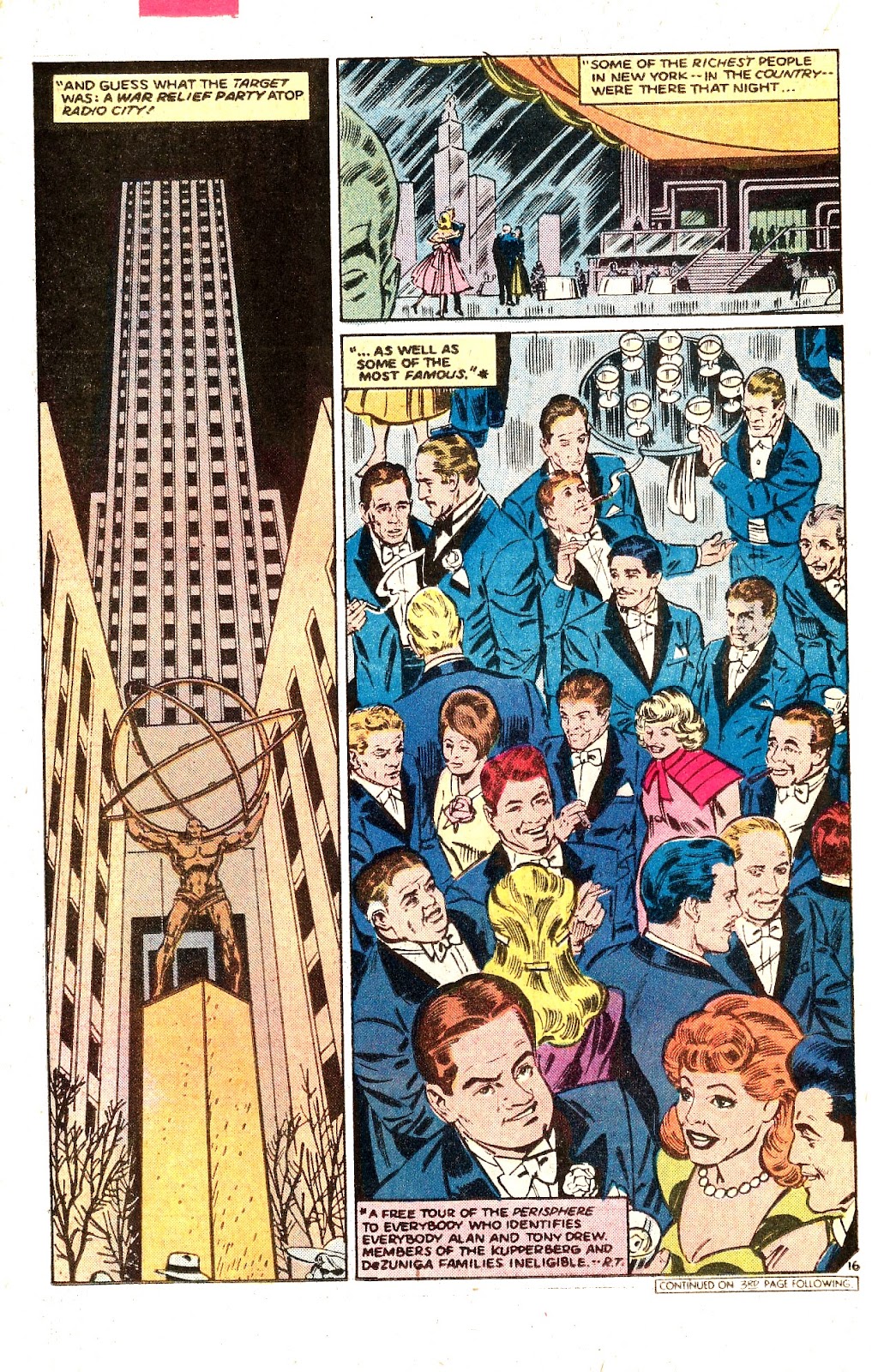 That's supposed to be Abbot & Costello, at the top, next to the waiter with the tray of drinks. Moving counter clockwise, we have: Louis Calhern, Humphrey Bogart, somebody's head, James Cagney and the Mrs, Ronald Reagan, Fiorello LaGuardia, a blond woman from behind, Bob Hope, Lucy & Desi, Errol Flynn, Jack Benny (with a question mark in Roy's listing), Edward G Robinson, George Burns & Gracie Allen, Jimmy Durante, Tyrone Power (also with a question mark) and Clark Gable. The guy Roy identifies as Benny looks more like George Raft, to me and "Tryone Power" looks nothing like him. Alan Kupperberg is no Al Hirschfeld. He's not even a Dick Gautier. Historical Notes: Roy is too early for the Hollywood Canteen. It opened, at 1451 Cahuenga Blvd, in Los Angeles, on October 3, 1942. The project was the brainchild of Bette Davis and John Garfield, with Jules Stein, president of MCA, heading the finance committee. Studios, stars and crew donated their time, labor and resources to renovate and operate the place, where food, drink, dancing and entertainment was completely free to service men and women. The price of admission was the uniform. There, you could find celebrities cook the food, waiting on tables, dancing with soldiers, sailors and air men, or telling jokes and singing. A similar operation, the Stage Door Canteen, was set up in New York.  (Marlene Dietrich and Rita Hayworth serving service men) A Hall of Honor displayed photos of celebrities in the Armed Services (or who had served previously).... 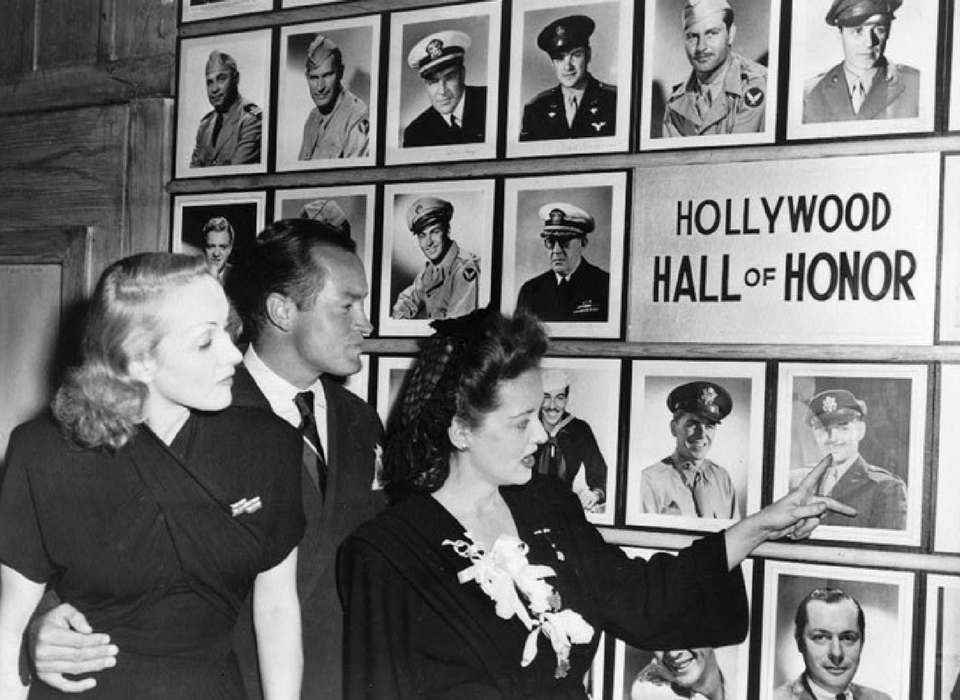 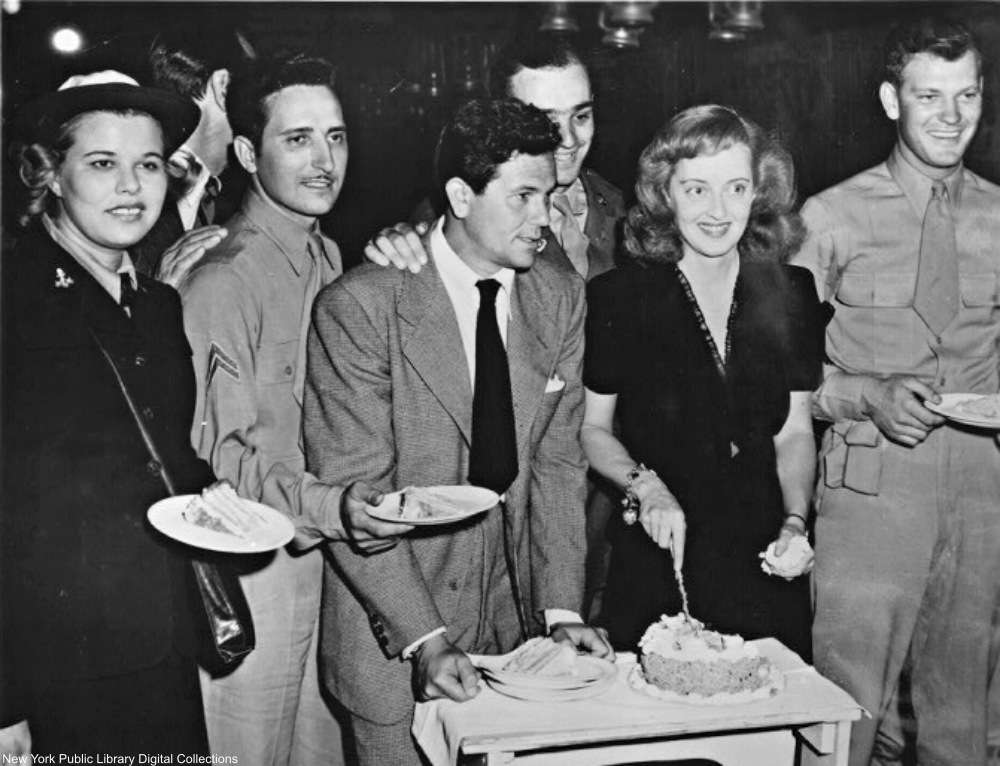 (Bette Davis & John Garfield, who gave life to the club) For many service members who passed through Los Angeles (and those who visited the Stage Door Canteen, in New York) it was a special memory of the time, a celebration of life before the horrors of war. Just imagine, seeing the faces from the movie screen cooking your food, serving your table, and being able to dance with a screen goddess.... The Canteen was made further famous by 1944 film, Hollywood Canteen, where two soldiers get to spend 3 days of leave at the Canteen, where one is the one millionth customer and the other gets to dance with Joan Crawford. The actual millionth customer, Sgt Carter Bell, received a kiss from Betty Grable and was escorted by Marlene Dietrich. September 1945: On September 2, the Final Instrument of Surrender is signed by the Japanese, officially ending the Second World War...  In attendance at the ceremony and one of the recipients of the signature pens was Gen Jonathan Wainwright, who had surrendered to the Japanese, after exhausting his ammunition and supplies. Wainwright was the son of a Spanish-American War veteran and the grandson of a Civil War veteran. he served in the Army during the Moro Rebellion, in the Philippines and with the 82nd Infantry, in WW1, seeing action in the Saint Mihiel and Meuse-Argonne Offensive. He was MacArthur's senior field commander on Luzon and was left to hold out in Corregidor, after MacArthur was evacuated, by presidential order. With food and ammunition exhausted, he surrendered to the Japanese, but he and his men and the civilian population were used as hostages , to force the surrender of the remaining forces, under Maj Gen Sharp. Sharp capitulated. Wainwright was the highest ranking American POW during WW2 and was as maltreated as other soldiers, under Japanese detention. When he was reunited with MacArthur, during the liberation of the Philippines, he was thin and gaunt, suffering from malnutrition. After witnessing the Japanese surrender, Wainwright flew to Manila and accepted the formal surrender of all remaining Japanese forces in the Philippines. On September 4, the Japanese surrendered on Wake Island and on the 12th they surrendered Singapore to the British. On the 18th, Japanese forces in Wuhan surrendered to the Chinese. Chiang Kai-Shek accepted formal surrender in Nanking, on the 9th. On September 8, US forces landed in Inchon and took over control of Korea, below the 38th Parallel, ultimately helping to establish the Republic of Korea. The Soviet Union occupied north of the 38th, eventually helping to establish the People's Republic of Korea, setting the stage for the Korean War. On September 2, Ho Chi Minh officially established the Democratic Republic of Vietnam. The Occupation of Japan began, with Douglas MacArthur as the Supreme Allied Commander and defacto military ruler of Japan. Preparations began for war crimes trials, leading to the attempted suicide of Gen Hideki Tojo, on the 11th. Tojo survived and was tried an executed. Later historians have accused MacArthur's staff of whitewashing the Emperor's complicity with the militarists and the actions of the military in conquered territories, pushing the blame onto Tojo. Obviously, there was a political impetus to that, as Japan could not be peaceably governed if the Emperor were put on trial. So, the narrative of the militarists isolating the Emperor and ruling in his name was developed (though with much truth to support it) to shift blame away from the Emperor allowing the military to have its way, unchecked. Without the Emperor's support, it is unlikely that the militarists could have pushed their agenda forward, including the propaganda campaigns aimed at the general populace, which fed the Japanese war machine. This is supported by the Emperor signaling he would surrender, to spare his people more nuclear bombs. There was a brief uprising in the general staff; but, loyalty to the Emperor was paramount and his blessing was required for all major decisions. On September 5, Iva Toguri stepepd forward to claim a $2,000 offer for an exclusive interview with Tokyo Rose, from Cosmopolitan Magazine and the Hearst Syndicate. She was arrested and Harry Brundidge, reneged on the interview fee and tried to sell the transcript of the interview as Toguri's confession. She was released for lack of evidence of any crimes, after a year in prison. She petitioned to return to the United States (she was born in Los Angeles) and was denied, largey through lobbying efforts by Walter Winchell. She was rearrested and brought to San Francisco, in 1948 and put on trial, for treason. She was charged with 8 counts of treason; but convicted on one, that she had delivered a broadcast that remarked about the loss of ships. She was fined $10,000 and sentenced to 10 years in prison and was paroled after 6 years. She moved to Chicago and settled there. In 1976, a Chicago Tribune investigation uncovered perjury in two of the witnesses against her. This was followed up by a piece on 60 Minutes. In 1977, President Gerald Ford issued a pardon of Toguri, on his last day in office. On January 15, 2006, the WW2 Veterans Committee presented the Edward J Herlihy Citizenship Award to her, which she considered the greatest honor of her life. In July of 1941, Iva Toguri sailed to Japan to visit an ailing relative. She had been issued a Certificate of Identification, instead of a passport. In August, she visited the American Consulate and expressed her desire to return home. Her request to return got caught up in the attack on pearl harbor and the State Department refused to certify her US Citizenship, in 1942. she was trapped as an alien, in Japan. the Japanese government pressured her and other japanese Americans in Japan to renounce her citizenship. She reused and was denied a ration card. She found work as a typist at a news agency and then for Radio Tokyo. She actually risked her life to smuggle food to a nearby prison camp and her broadcasts never carried any anti-American propaganda, as later shown in movies. The scripts were actually farcical sketches, filled with double entendres that mocked Japanese propaganda, as censors were unable to catch the significance of many references. She was never referred to as Tokyo Rose, only using the name Ann and Orphan Ann, in broadcasts. The Australian prisoner, Charles Cousens, who wrote many of the scripts, testified as a defense witness that she did not broadcast any anti-American propaganda. In April 1945, she married Felipe D'Aquino, a Portugese citizen of Japanese descent. He was repeatedly denied entry into the US and Toguri reluctantly divorced him in 1980. On September 10 Vidkun Quisling, the Norwegian politician who collaborated with the German invasion and was the puppet leader, under the Nazis, was sentenced to death. His name became synonymous with treason as collaborators became known as "quislings." He was executed by firing squad on October 24, after giving testimony in other trials. On Septemer 20, Mohandas Gandhi and Jawaharlal Nehru issue demands that all British troops be withdrawn from India, signaling a new phase in the struggle for India's independence. On September 24, proving that that world hadn't learned a thing, anti-semitic riots broke out in Topolcany, Slovakia. One of the underlying causes was Holocaust survivors demanding the return of stolen property, sparking rumors of nationalization of schools, replacing Catholic nuns with Jewish teachers and that a Jewish doctor who was vaccinating children at a school was poisoning the children. The Communists took advantage of the riots and hysteria to illustrate that the government was ineffective. Similar acts of violence occurred in other areas of Soviet control, beginning with the German retreat and continuing after their surrender. Many areas had been ravaged by war and scarce resources led to fear and violence, with Soviet officials and Allies often allowing the violence to occur and use it for propaganda purposes against political rivals. On September 5, Igor Gouzenko, a code clerk at the Soviet Embassy, in Ottawa, defects and provides evidence of widespread spying in the US and Canada.He presented 109 documents that indicated the Soviet Union's attempts to gain nuclear secrets and plant "sleeper agents" in the West. He initially approached the Royal Canadian Mounted Police, but wasn't initially believed. he tried the Ottawa Jornal newspaper and the Deprtment of Justice. He moved his family into a neighbor's apartment, fearing his defection was discovered by Russian security. That night, agents broke into his apartment and searched for documents, leaving only after the Ottawa Police became involved. The RCMP then took his claims seriously and he was moved to Camp X, a secret facility used for agents during the war, where he was debriefed by officers from MI5 (as it was considered an internal security matter, with Canada still part of the British Empire) and the FBI. Prime Minister MacKenzie King wanted to avoid the whole situation, but his hand was forced. the evidence he provided was vital in uncovering Soviet espionage activities and was one of the touchpoints of the Cold War. he later made tv appearances, related to his memoirs and a novel, under a hood... 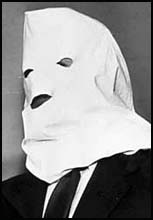 Gouzenko lived the rest of his life in the Toronto area, under the name of George Brown.
|
|



